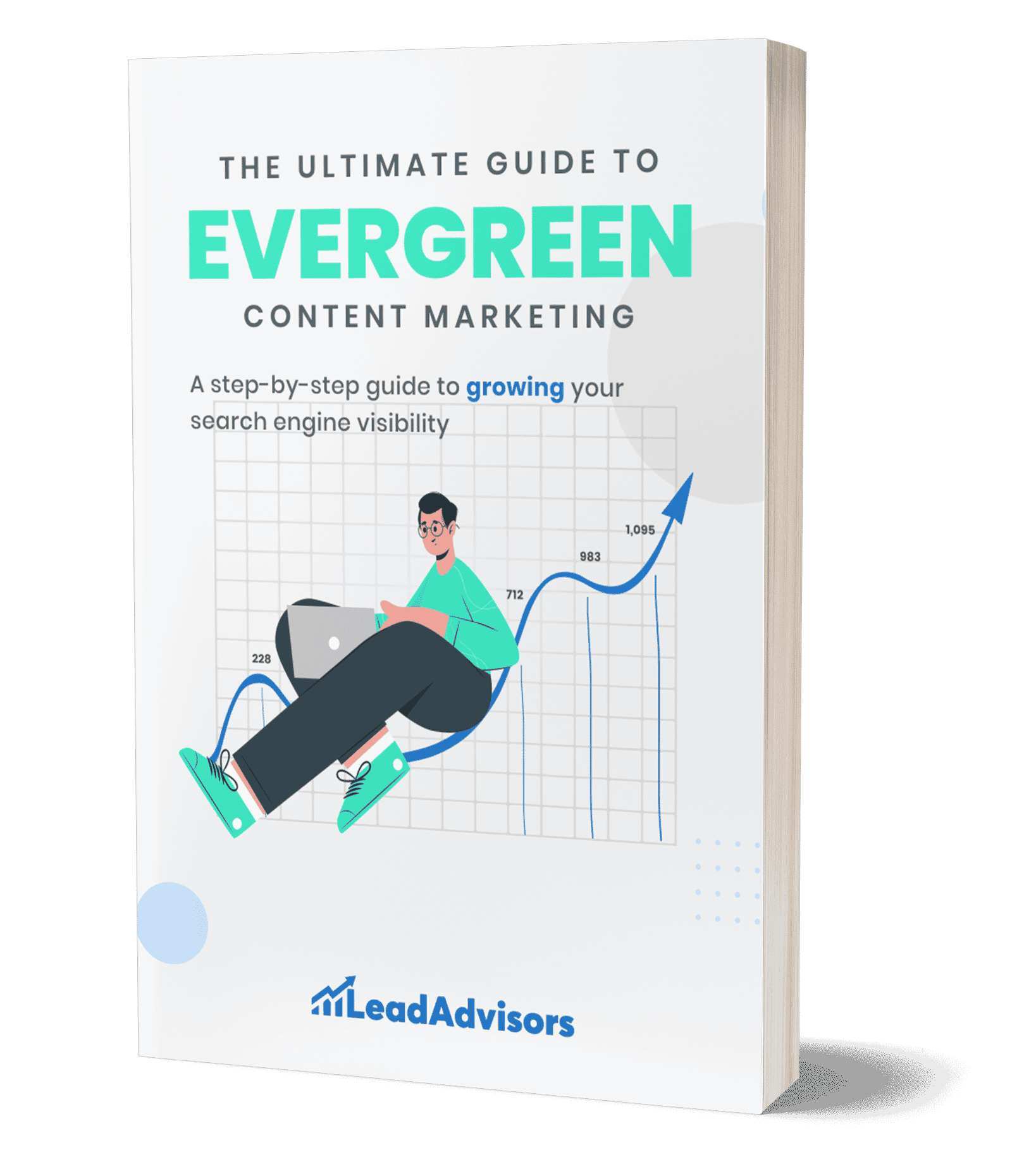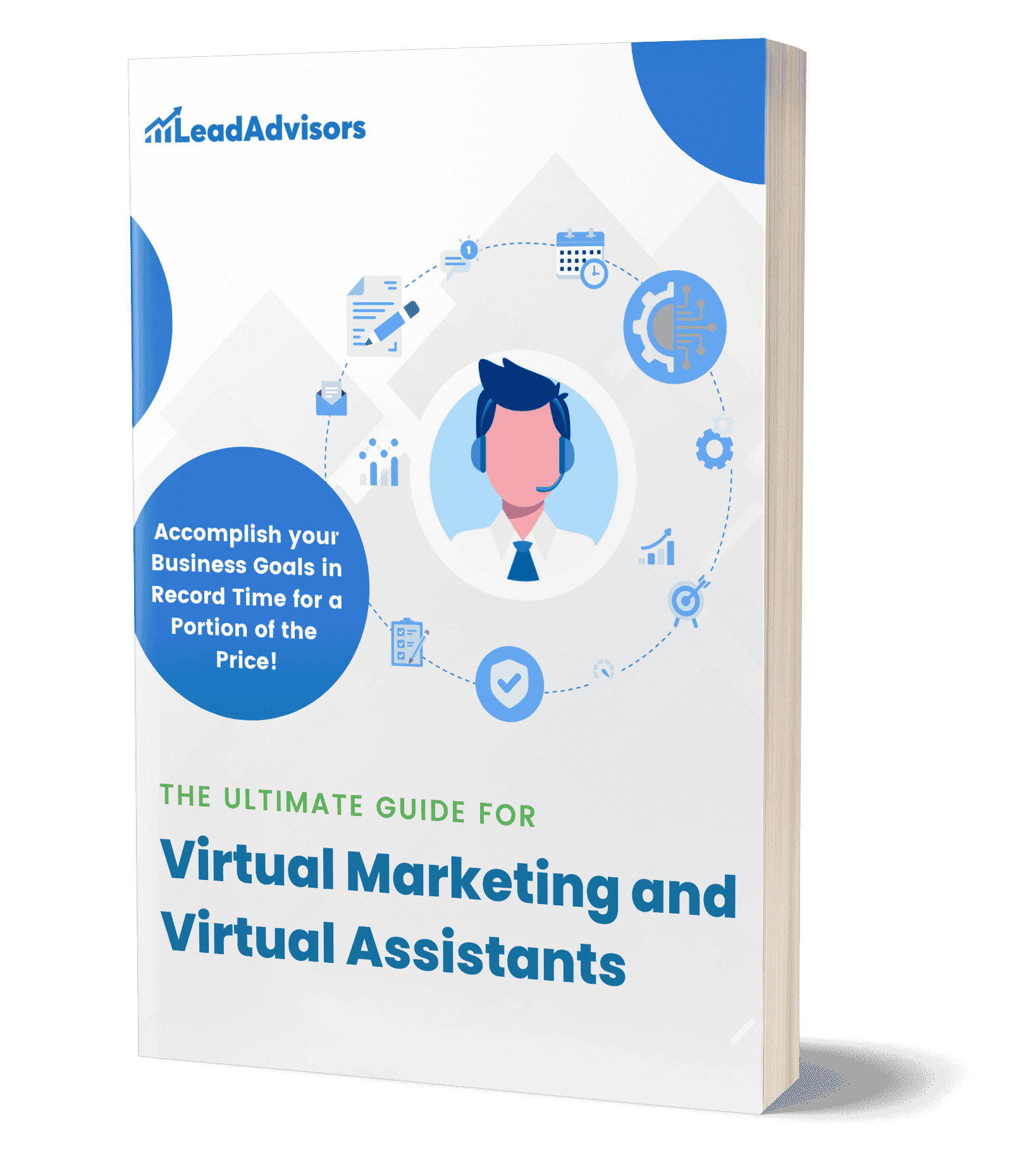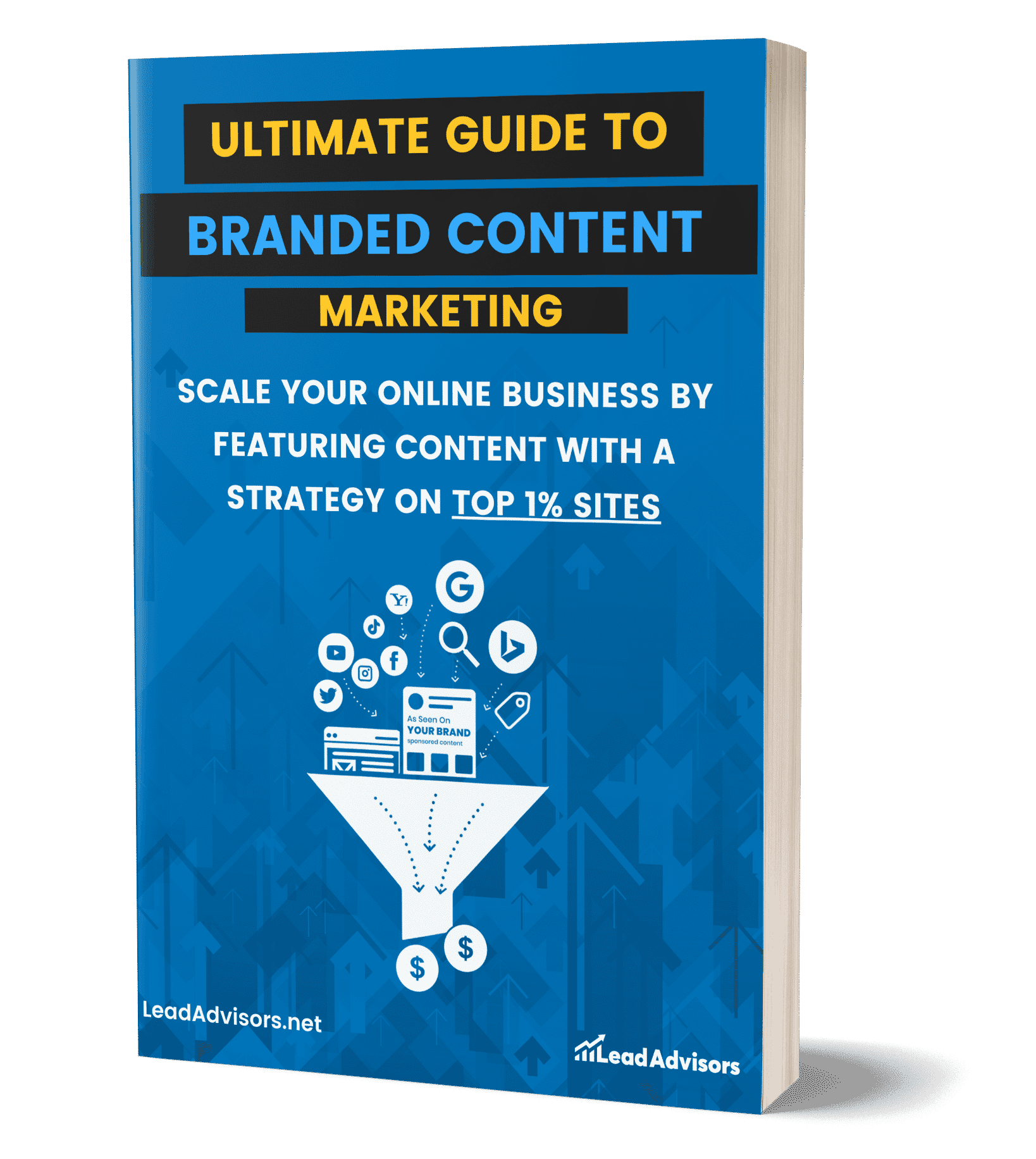Blogs have evolved far beyond personal journals. Today, they’re powerful platforms for sharing ideas, growing communities, and building sustainable income. This guide features over 100 real best blog examples from a wide range of niches.. You’ll see how content, design, monetization, and tools come together to create blogs that actually grow and stick around.
Need a head start? Let us explore blogging website example and handle the setup, optimization, and long-term growth.
What Makes a Great Blog in 2025
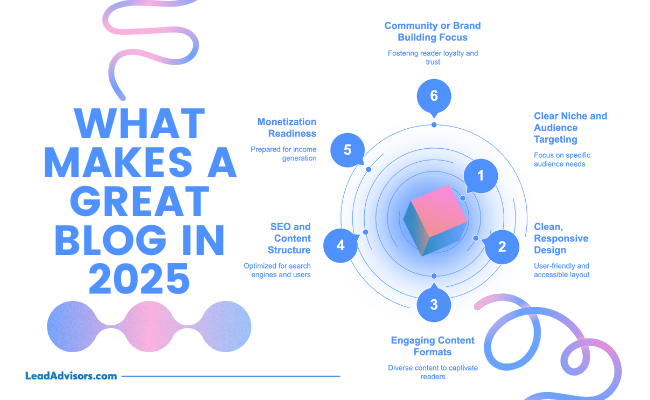
Building a blog that works today takes more than good ideas and decent writing. The best blogs—whether it’s a parenting blog, a business blog, or an entertainment news hub—are structured with purpose and built to connect.
Here’s what sets the most effective blogs apart this year:
Clear Niche and Audience Targeting
Blogs that try to speak to everyone often miss the mark. The strongest blogs know exactly who they’re speaking to. Whether it’s new parents looking for toddler activities (like a parenting blog), marketers wanting SEO tips, or travelers seeking budget itineraries, these blogs stay focused. This clarity allows you to create content that directly answers your readers’ questions, solves their problems, or reflects their lifestyle.
Bottom line: Know your audience, speak their language, and stay consistent with your topic.
Clean, Responsive Design
A blog’s layout should never get in the way of reading. Even an award winning blog keeps its layout simple—mobile-friendly and fast. Simple design, mobile-friendliness, and fast loading times are must-haves. A clear header, readable fonts, and an easy-to-use menu keep people around longer. Whether someone visits from their phone or desktop, the experience should be smooth and frustration-free. Good design also supports your content. You don’t need flashy effects—clarity wins.
Read More: 7 Bad UX Design Examples You Must Avoid
Engaging Content Formats
People take in information in different ways. The most successful and popular blogs mix things up: long-form articles, list posts, short videos, infographics, quick tutorials, or even photo essays. Adding variety keeps your blog interesting and helps more people connect with your content. Video walkthroughs, embedded audio, and high-quality images give your posts more depth and keep visitors engaged longer.
SEO and Content Structure
Search traffic still matters—a lot. But it’s not just about keywords. Structuring your content in a way that makes sense for both readers and search engines is key. Whether you’re building an entertainment news site or a niche parenting blog, internal linking and smart categorization help blogs rank and retain readers. Use headings properly, answer real search queries, and group related topics together. A smart internal linking system, pillar pages, and clearly labeled categories help with both SEO and user navigation.
Monetization Readiness
Many blogs start out as passion projects, but with the right setup, they can earn income too. Whether you’re thinking about running display ads, linking to affiliate products, or selling your own digital resources, it’s smart to plan for that early. Some famous blogs started out small, but they grew by choosing the right layout and monetization model from day one. Choose a layout and platform that can support revenue streams without compromising the user experience.
Community or Brand Building Focus
The strongest blogs feel like more than just websites—they feel like spaces people want to return to. The strongest blogs feel like more than just websites—they feel like spaces people want to return to. A consistent brand voice builds trust, even if it’s just a sample of a blog that reflects real stories and experiences. Whether it’s through comments, email newsletters, social media, or a clear voice in your writing, building a sense of familiarity and connection matters. When readers feel like they know you, they’re more likely to subscribe, share, and support your work.
Tip: A consistent brand voice builds trust and makes your content more recognizable. Think of it as the tone and personality of your blog. Whether you’re casual, professional, funny, or reflective—keep it steady across your writing, visuals, and communication.
Want to lay the groundwork right? Check out our step-by-step guide to starting a successful blog.
Personal Blog Examples
Personal blogs continue to thrive because they offer something most polished media can’t—honesty. These sites are often built around lived experiences, and they resonate because they sound real. Whether it’s solo travel, parenthood, or healing after illness, personal blogs stand out when the voice behind them is clear and consistent.
Here are some strong examples worth checking out:
Young Adventuress
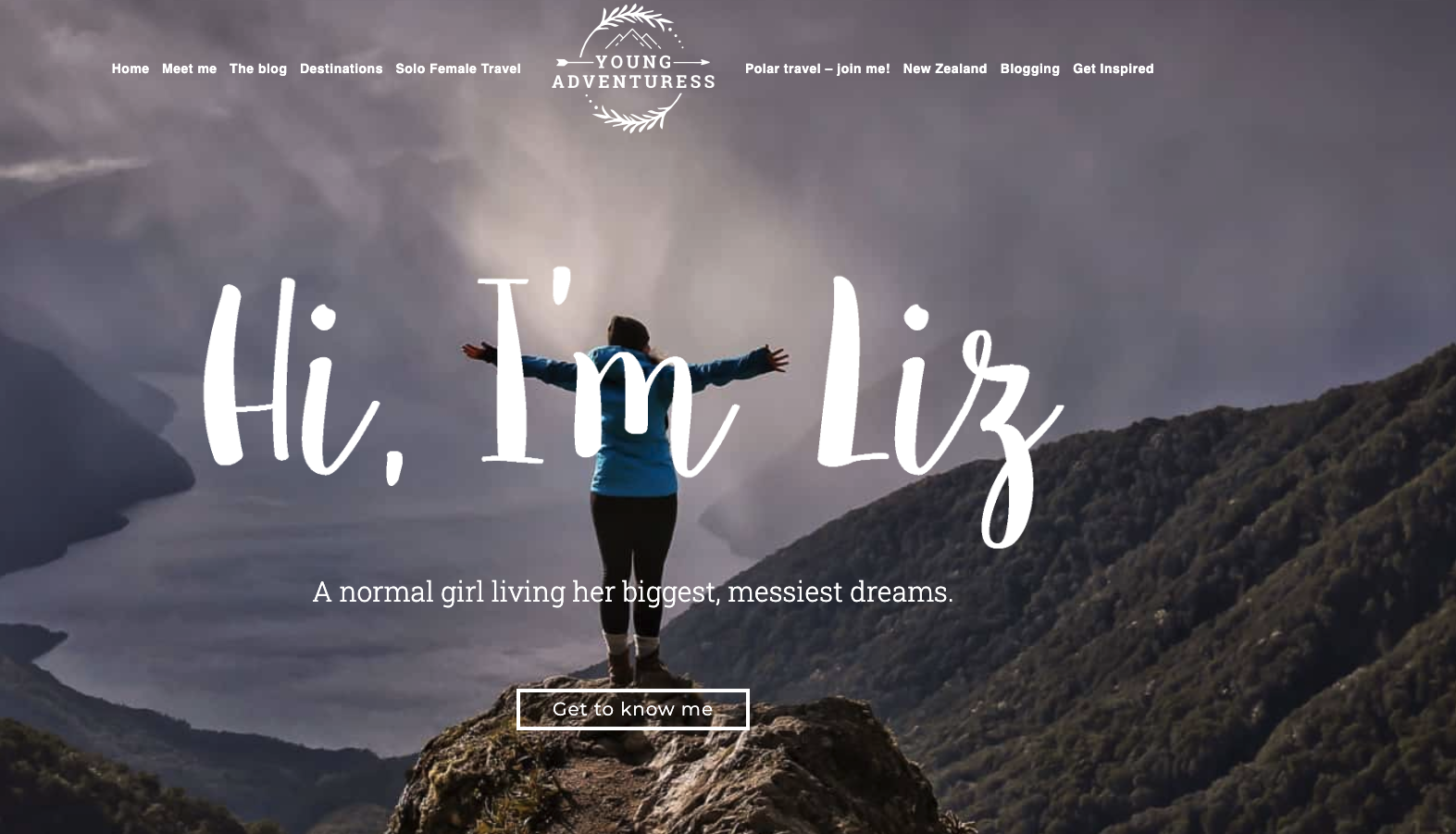 Liz Carlson started her blog as a way to document life abroad and eventually turned it into a go-to resource for solo female travelers. What makes her blog stand out isn’t just the photography or the destination tips—it’s the way she writes. Her posts often feel like reading a letter from a friend who’s not afraid to say what’s hard, weird, or hilarious about life on the road.
Liz Carlson started her blog as a way to document life abroad and eventually turned it into a go-to resource for solo female travelers. What makes her blog stand out isn’t just the photography or the destination tips—it’s the way she writes. Her posts often feel like reading a letter from a friend who’s not afraid to say what’s hard, weird, or hilarious about life on the road.
Zen Habits
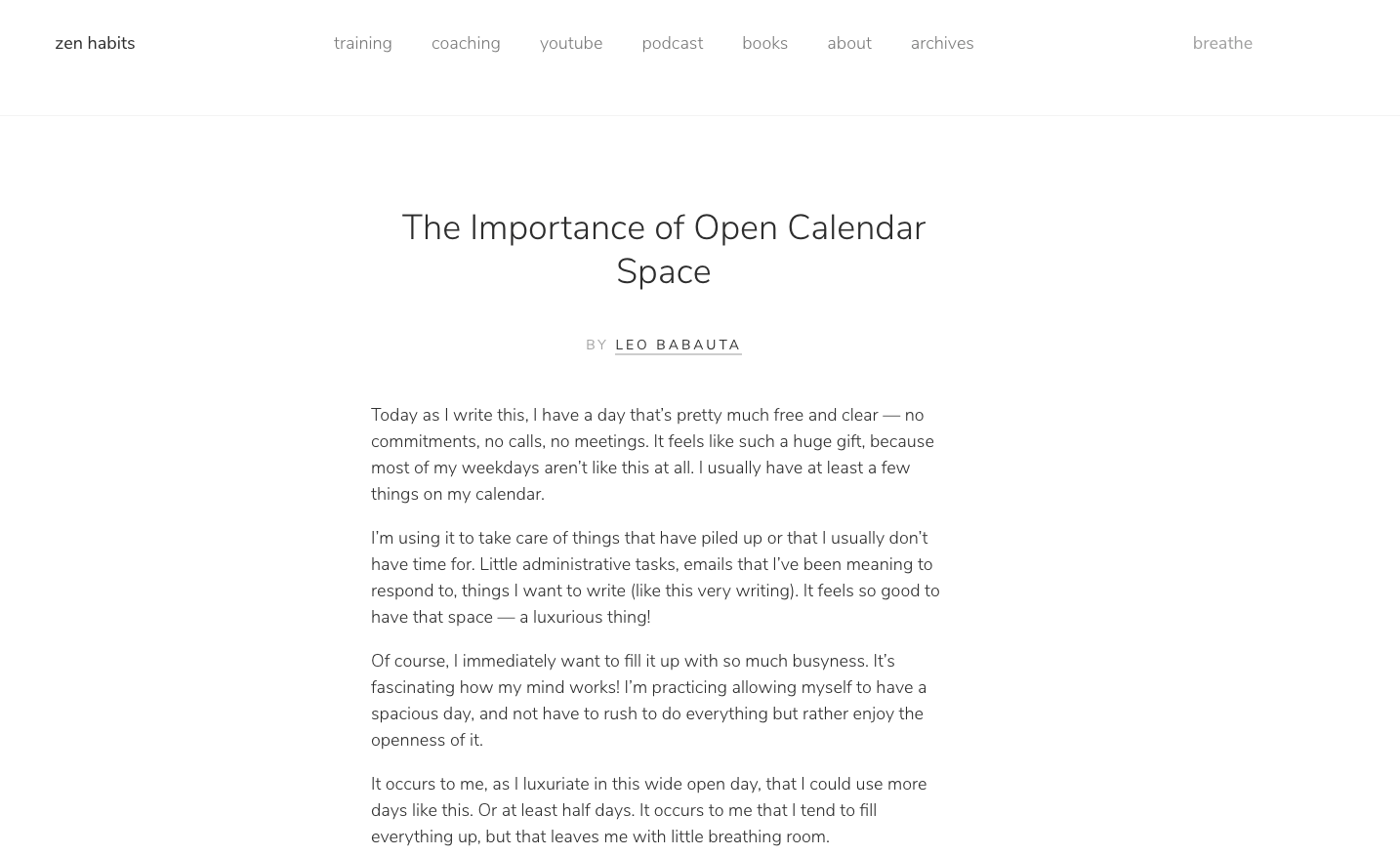 Leo Babauta’s site is one of the most well-known in the simplicity space. It’s not flashy—on purpose. His focus is on reducing stress, cutting through the noise, and helping people think more clearly. Each post is short, often reflective, and always aimed at making life feel a little lighter. His consistent, calming voice has attracted millions of readers.
Leo Babauta’s site is one of the most well-known in the simplicity space. It’s not flashy—on purpose. His focus is on reducing stress, cutting through the noise, and helping people think more clearly. Each post is short, often reflective, and always aimed at making life feel a little lighter. His consistent, calming voice has attracted millions of readers.
Dad or Alive
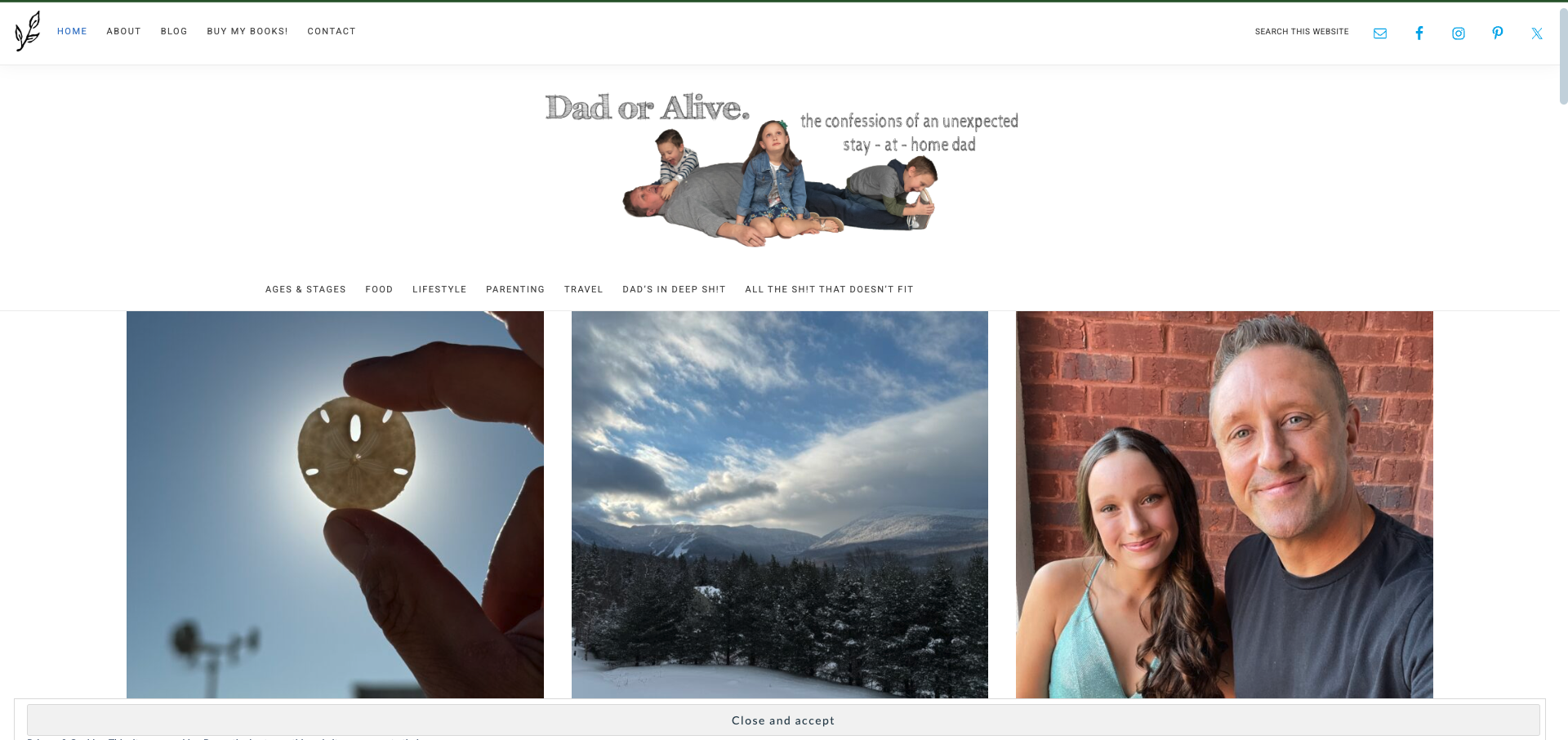 Adrian Kulp takes a different approach. His blog is filled with humor and chaos—basically what you’d expect from someone raising kids full-time. It’s not sugarcoated, and that’s the appeal. Adrian shares honest reflections, mistakes, and wins, along with stories about everyday parenting that make you laugh or nod in agreement.
Adrian Kulp takes a different approach. His blog is filled with humor and chaos—basically what you’d expect from someone raising kids full-time. It’s not sugarcoated, and that’s the appeal. Adrian shares honest reflections, mistakes, and wins, along with stories about everyday parenting that make you laugh or nod in agreement.
Tony Pappalardo Health Blog
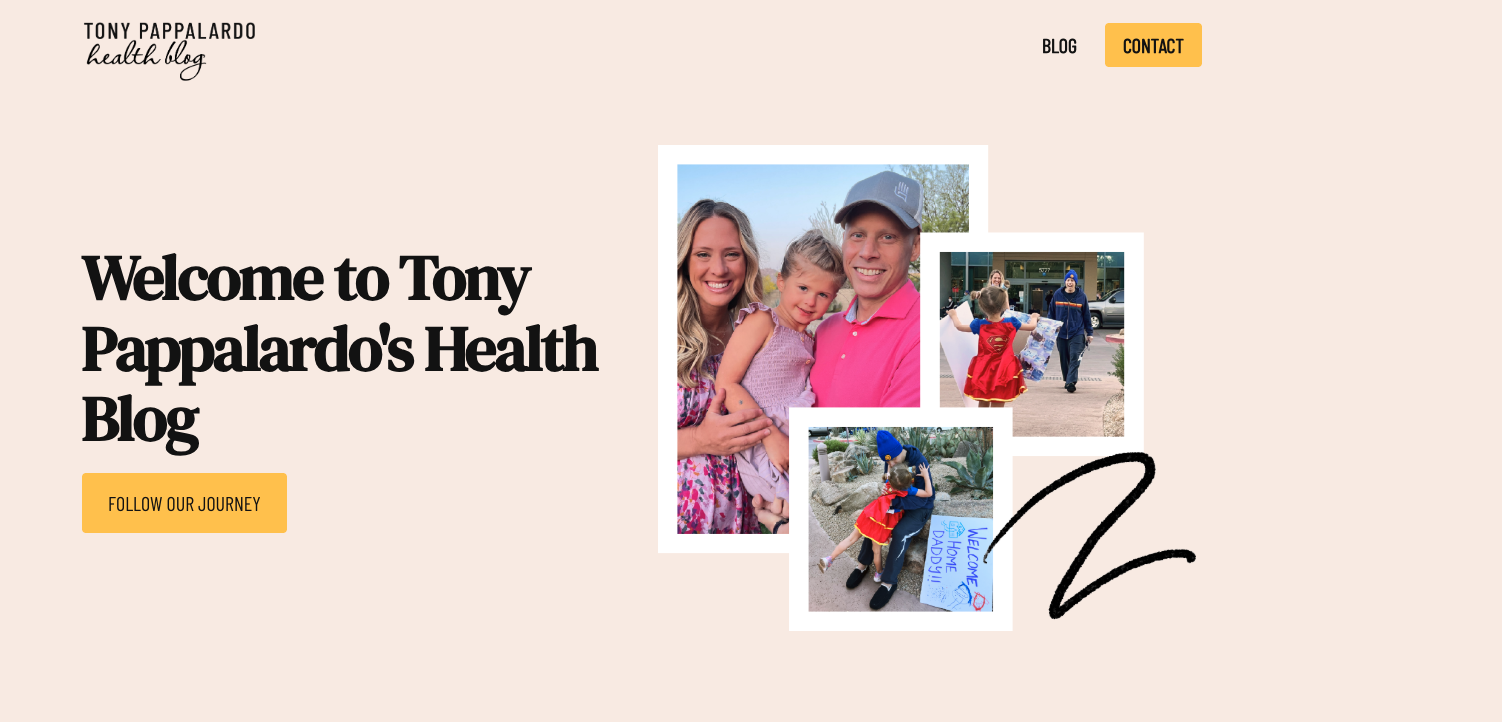
This blog stands out for its vulnerability. Tony and his wife Frances share personal life stories about navigating a serious cancer diagnosis, including their decisions around treatment and healing. It’s a space for anyone dealing with illness or looking for support. Their writing is clear and heartfelt, grounded in real experiences.
A Cup of Jo
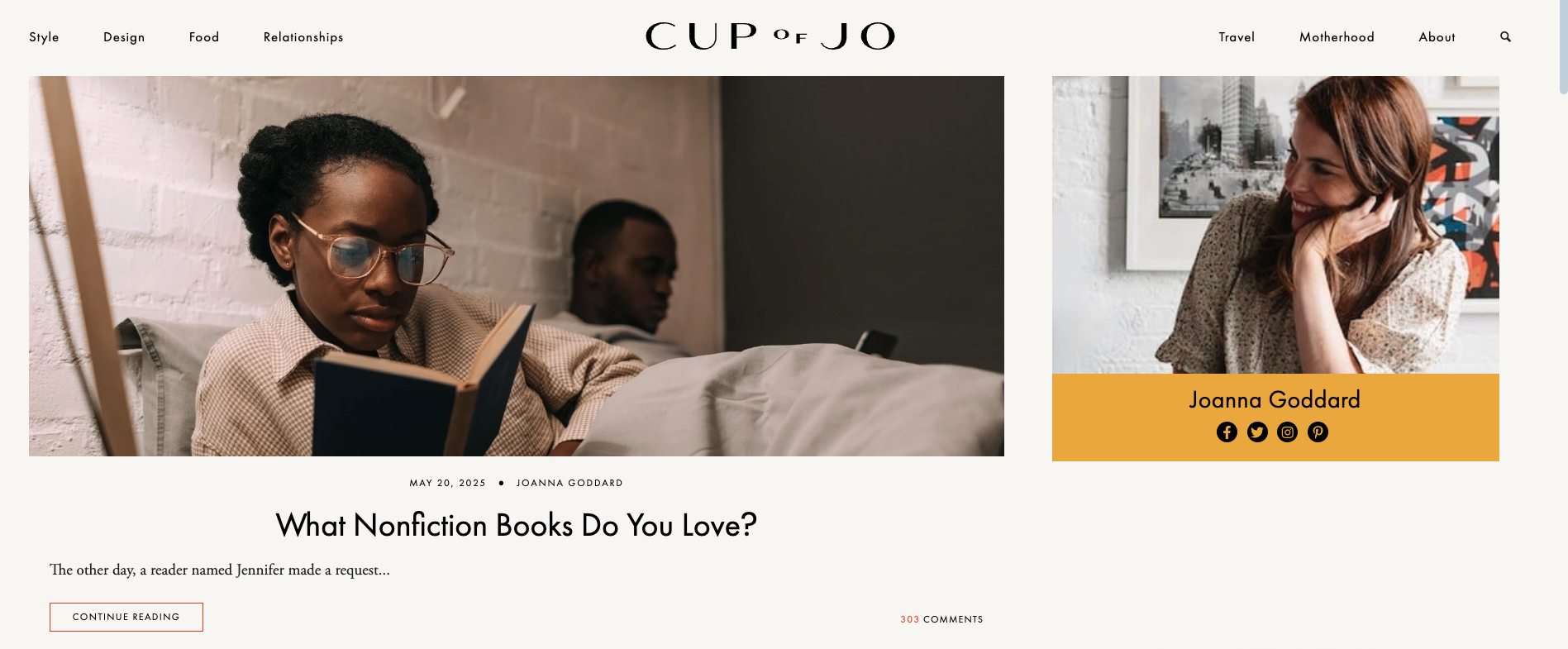 Joanna Goddard’s site started small and now has a full team behind it, but it still feels personal. That’s partly because of her writing style and partly because she invites guest contributors who add depth without losing the tone of the blog. Whether it’s a thoughtful take on relationships or a fun style roundup, the blog has kept a warm and inclusive vibe throughout the years.
Joanna Goddard’s site started small and now has a full team behind it, but it still feels personal. That’s partly because of her writing style and partly because she invites guest contributors who add depth without losing the tone of the blog. Whether it’s a thoughtful take on relationships or a fun style roundup, the blog has kept a warm and inclusive vibe throughout the years.
Note: What ties these blogs together isn’t their size or design—it’s the voice behind them. When readers can tell there’s a real person on the other side of the screen, they’re more likely to return, share posts, or subscribe. The stronger and more consistent your voice, the more likely people will connect with it.
Lifestyle Blog Examples
Lifestyle blogs reflect the interests, routines, and values of their creators. They often combine multiple themes like home decor, fashion trends, wellness, and personal growth. A strong visual identity and consistent tone go a long way in making these sites memorable.
A Beautiful Mess
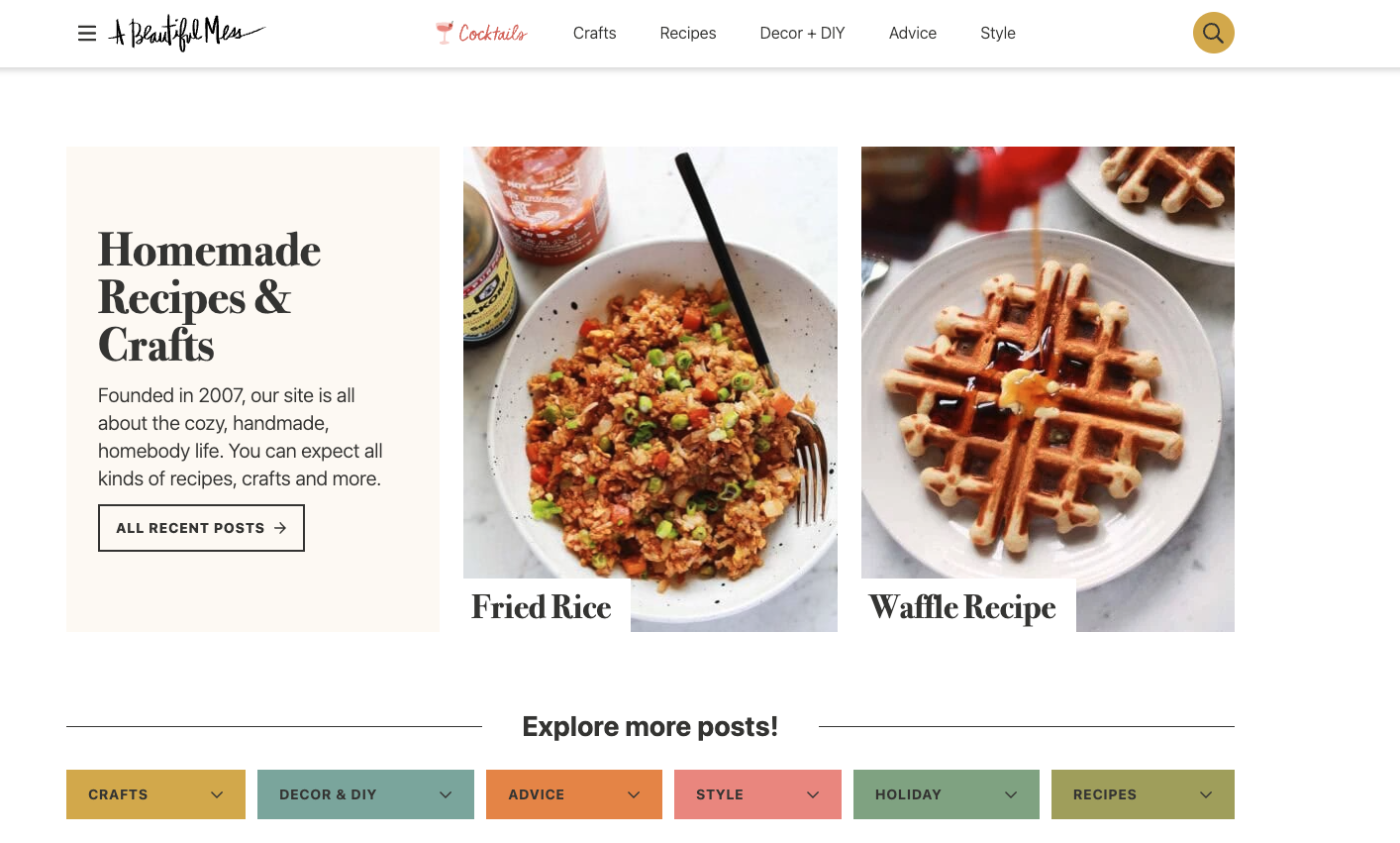 Elsie and Emma built this blog into a creative hub filled with DIY crafts, home projects, and recipes. It’s full of color and personality, and it’s clear they’ve designed it to make readers feel capable of trying something new, whether it’s a holiday wreath or a new paint color for a room.
Elsie and Emma built this blog into a creative hub filled with DIY crafts, home projects, and recipes. It’s full of color and personality, and it’s clear they’ve designed it to make readers feel capable of trying something new, whether it’s a holiday wreath or a new paint color for a room.
Cupcakes & Cashmere
 Emily Schuman’s blend of lifestyle tips, style, and home inspiration has aged well. She writes with polish, but the tone still feels personal. Readers come for the outfit ideas or design tips and stay because the content is approachable and consistent.
Emily Schuman’s blend of lifestyle tips, style, and home inspiration has aged well. She writes with polish, but the tone still feels personal. Readers come for the outfit ideas or design tips and stay because the content is approachable and consistent.
The Good Trade
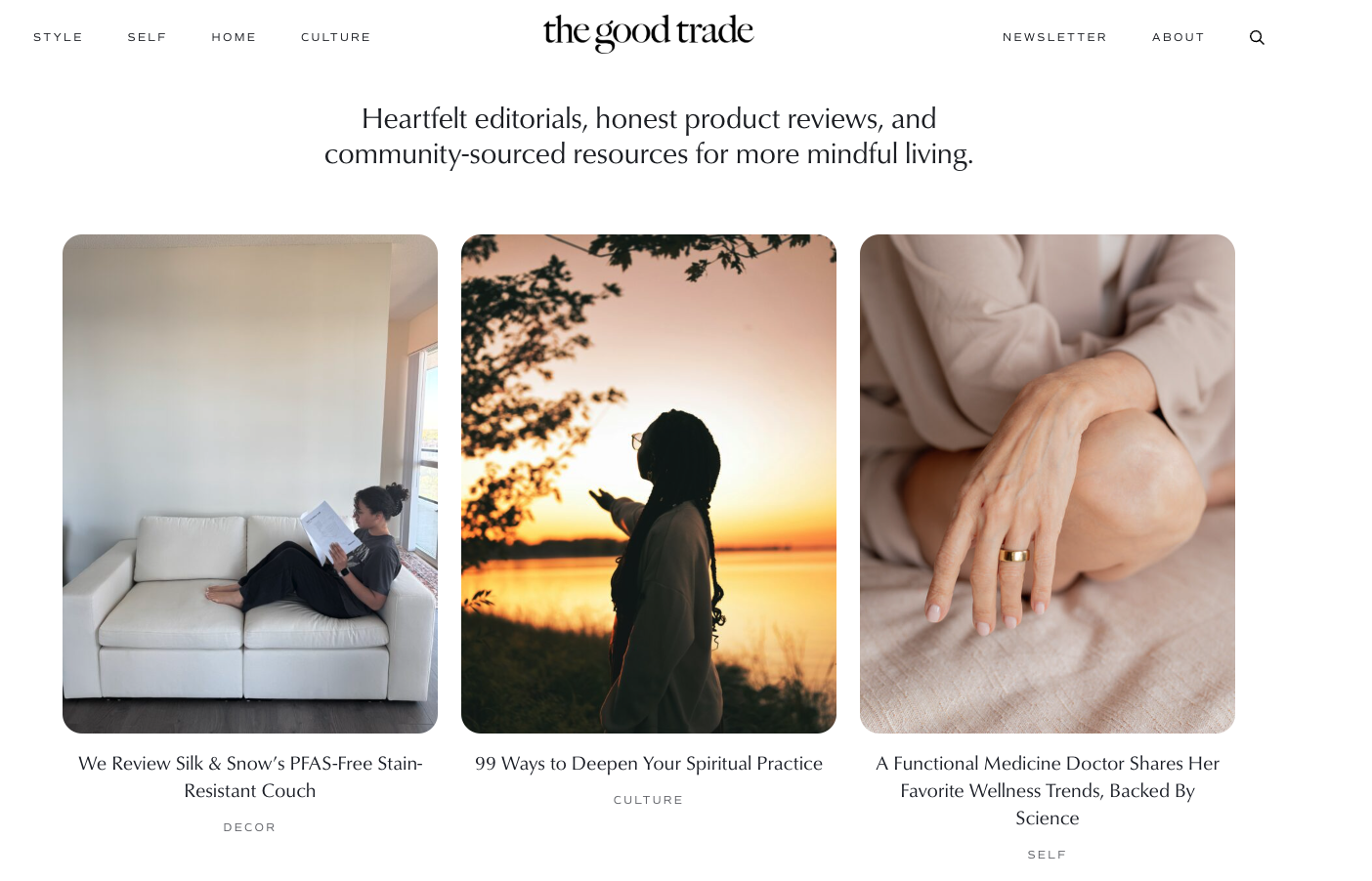 This blog stands out for its thoughtful, well-edited content. It covers sustainable fashion, slow living, and wellness without sounding preachy. The tone is calm, and the visuals are clean—perfect for readers who want to slow down and make intentional choices.
This blog stands out for its thoughtful, well-edited content. It covers sustainable fashion, slow living, and wellness without sounding preachy. The tone is calm, and the visuals are clean—perfect for readers who want to slow down and make intentional choices.
Sincerely Jules
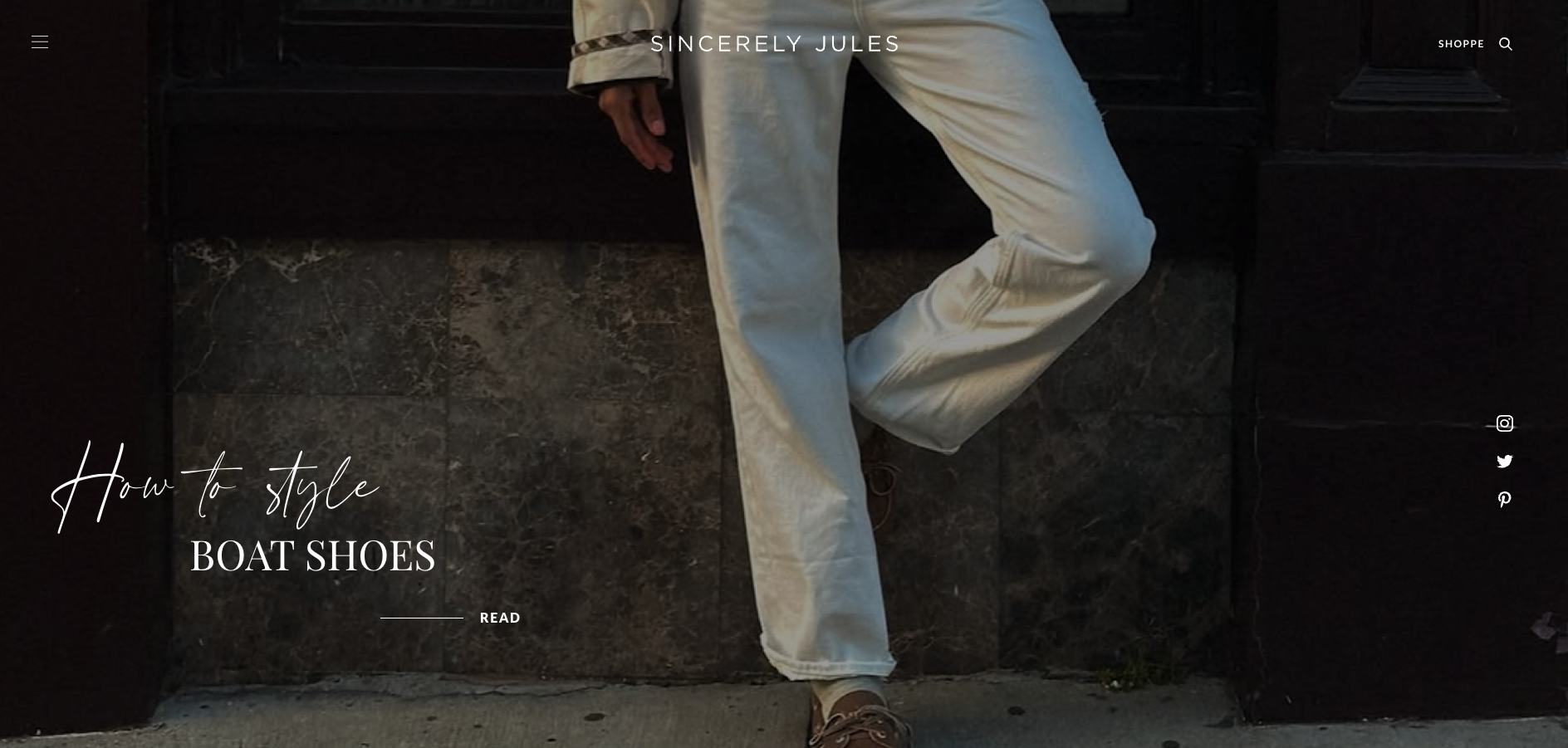 Julie Sariñana shares her life through beautifully composed photography. While fashion is central, she also weaves in travel blogging, beauty, and glimpses of daily life. Her layout and visuals work well on mobile, and her content has built a loyal, style-conscious following.
Julie Sariñana shares her life through beautifully composed photography. While fashion is central, she also weaves in travel blogging, beauty, and glimpses of daily life. Her layout and visuals work well on mobile, and her content has built a loyal, style-conscious following.
Wit & Delight
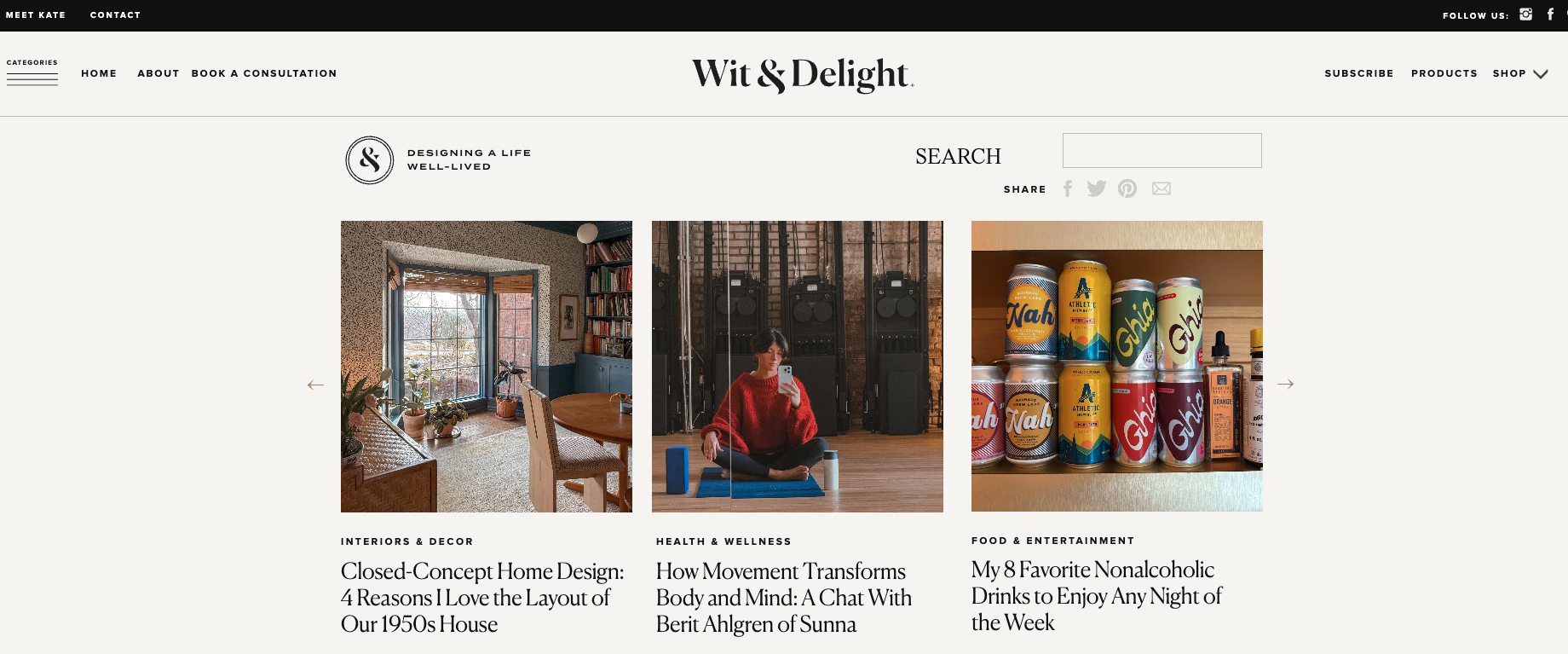 Created by designer and writer Kate Arends, Wit & Delight started as a personal outlet and has grown into a widely respected lifestyle blog. It blends home design, mental health, and intentional living, with content that often draws from Kate’s personal experiences.
Created by designer and writer Kate Arends, Wit & Delight started as a personal outlet and has grown into a widely respected lifestyle blog. It blends home design, mental health, and intentional living, with content that often draws from Kate’s personal experiences.
Design Tip: Use modular grids or visual blocks to help readers easily browse content across categories like home, style, or wellness. This keeps things organized even if your topics vary widely.
Want better search rankings? Learn how to format an SEO-friendly blog post.
Travel Blog Examples
Travel blogs help readers plan trips or simply enjoy the experience through someone else’s lens. Strong visuals, practical tips, and a clear structure set the best ones apart.
Nomadic Matt
 Matt Kepnes is one of the most well-known names in budget travel. His posts include detailed itineraries, city guides, and practical budgeting expert advice. He’s also transparent about costs, which makes his content useful for a wide range of travelers.
Matt Kepnes is one of the most well-known names in budget travel. His posts include detailed itineraries, city guides, and practical budgeting expert advice. He’s also transparent about costs, which makes his content useful for a wide range of travelers.
The Blonde Abroad
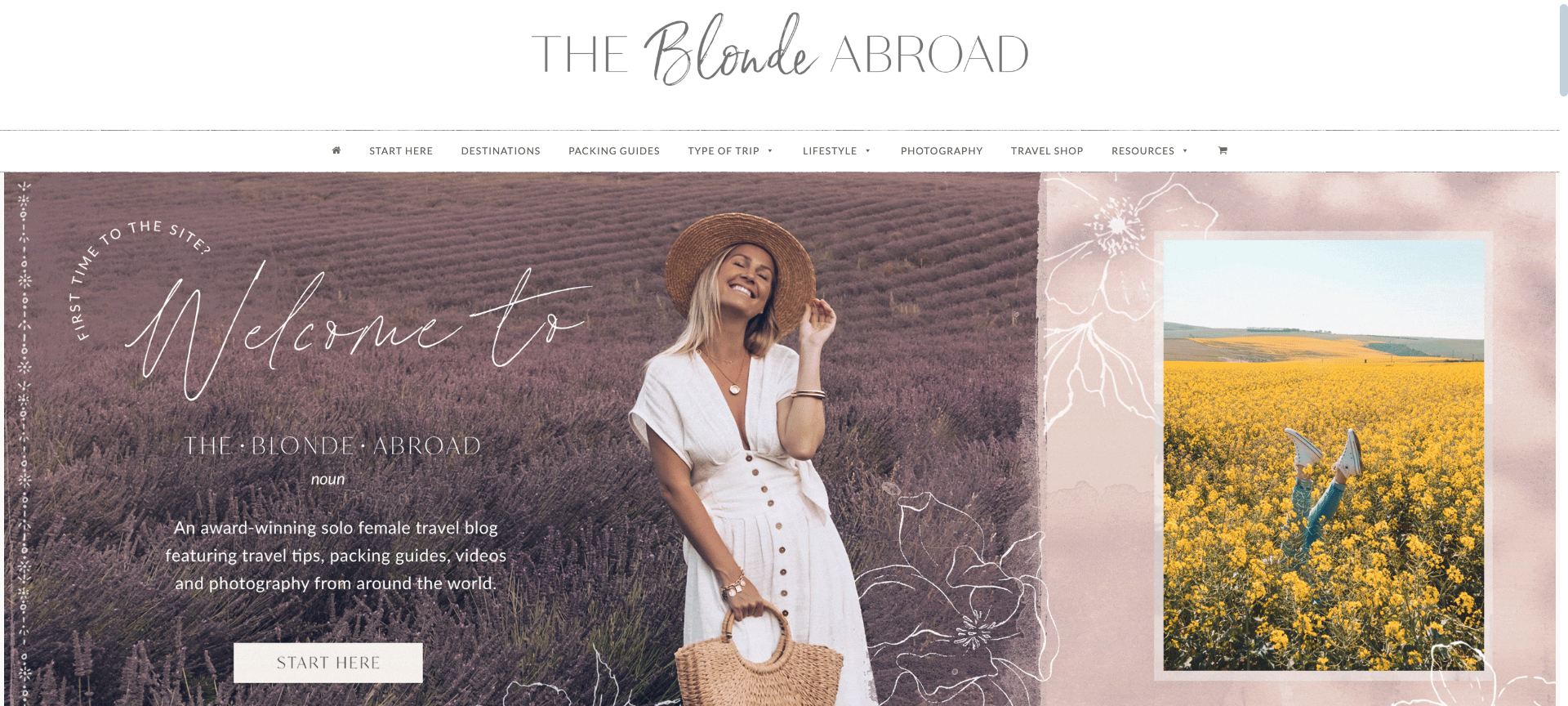 Kiersten Rich writes with a focus on solo female travel. Her blog offers tips by destination and interest—everything from photography tips to packing lists. Her voice is clear, and the design is easy to navigate, even for new readers.
Kiersten Rich writes with a focus on solo female travel. Her blog offers tips by destination and interest—everything from photography tips to packing lists. Her voice is clear, and the design is easy to navigate, even for new readers.
Chasing Buffaloes and Beyond
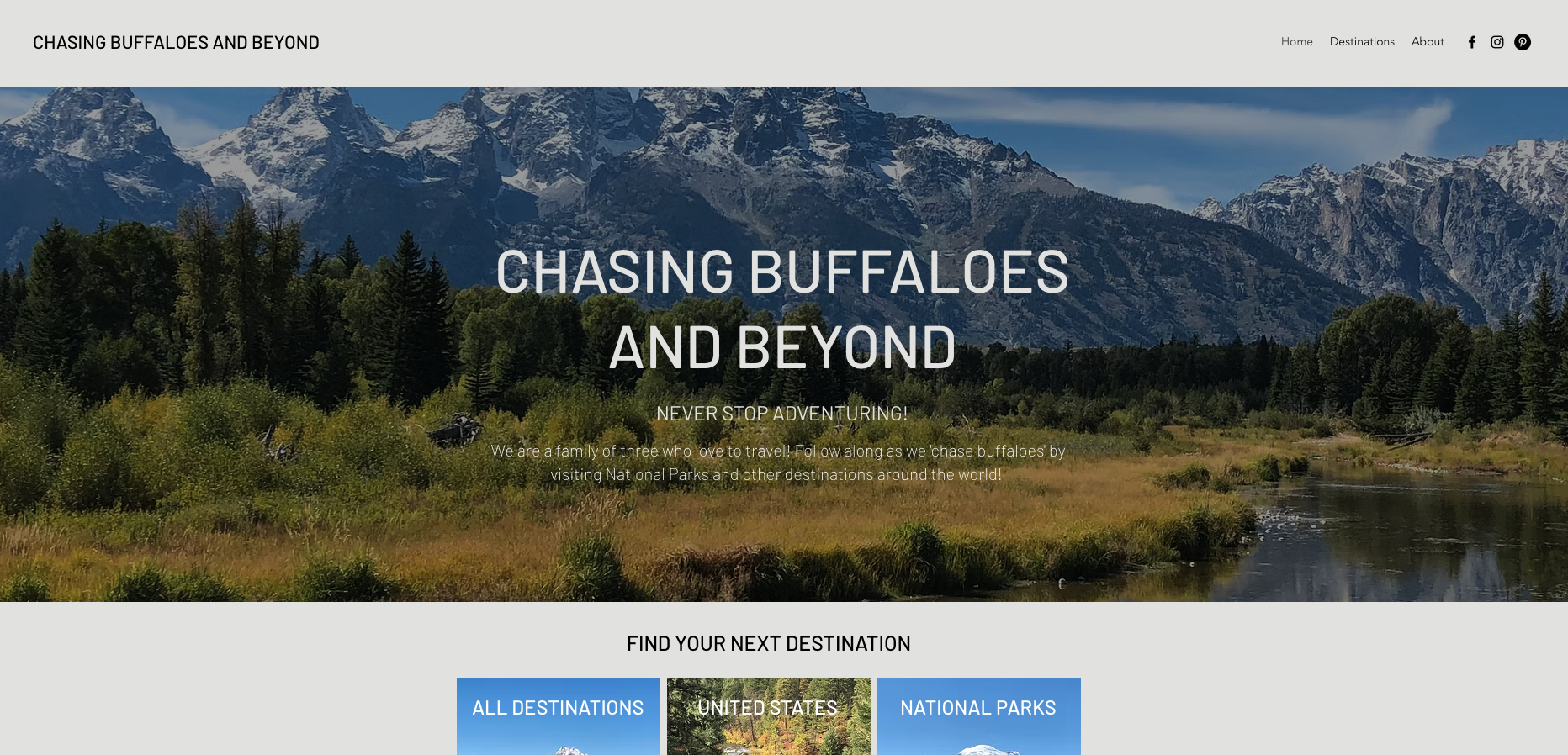 This blog follows a family’s national park trips and outdoor experiences. The writing is casual and encouraging, and the focus on family-friendly travel makes it stand out. It’s a great example of how personal stories and helpful info can work together.
This blog follows a family’s national park trips and outdoor experiences. The writing is casual and encouraging, and the focus on family-friendly travel makes it stand out. It’s a great example of how personal stories and helpful info can work together.
The Planet D
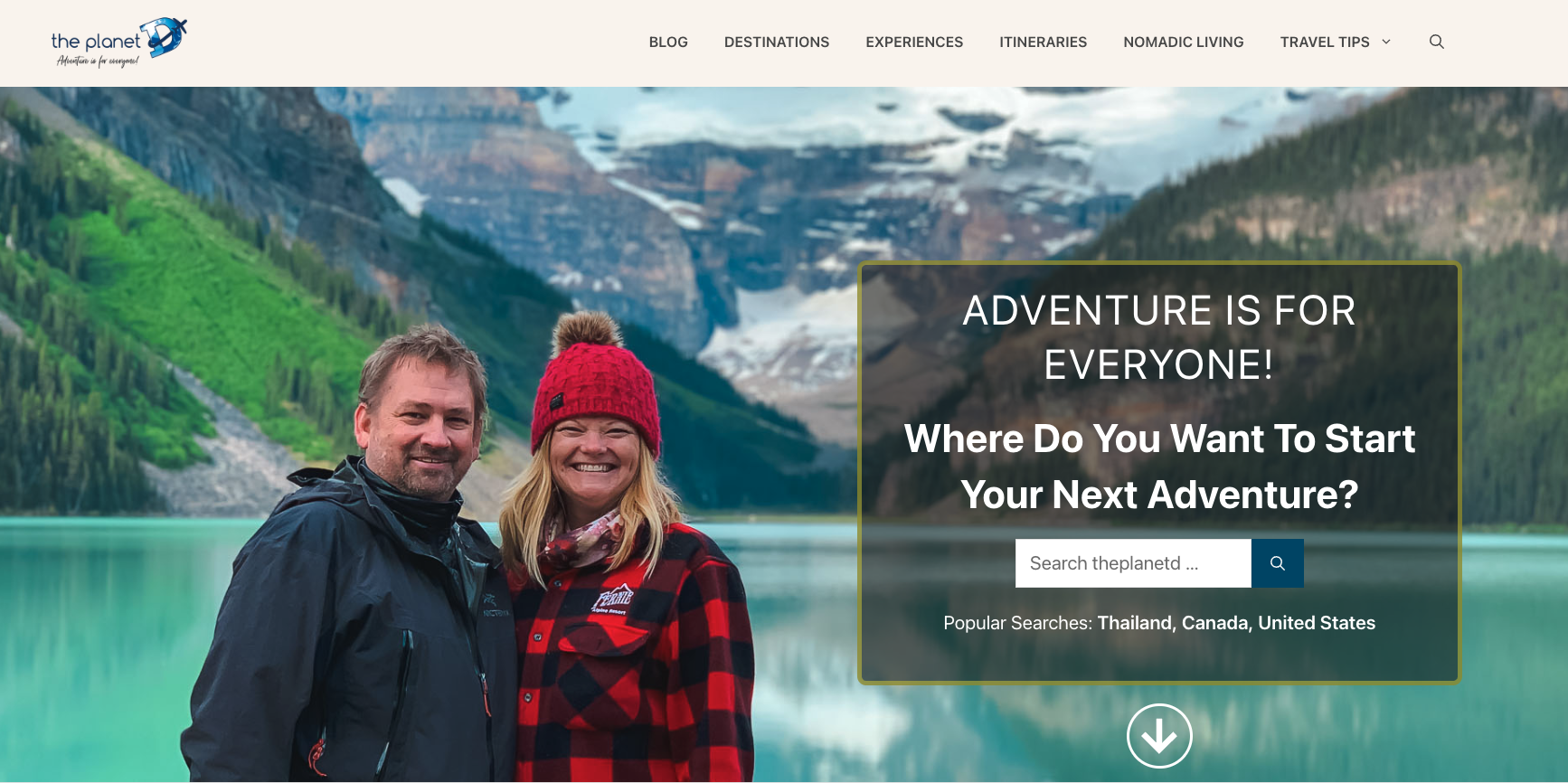 Dave and Deb offer comprehensive adventure travel tips. They’ve been to over 100 countries and cover everything from road trips to remote excursions. Their photography is strong, and each post usually includes gear suggestions and planning notes.
Dave and Deb offer comprehensive adventure travel tips. They’ve been to over 100 countries and cover everything from road trips to remote excursions. Their photography is strong, and each post usually includes gear suggestions and planning notes.
Salt in Our Hair
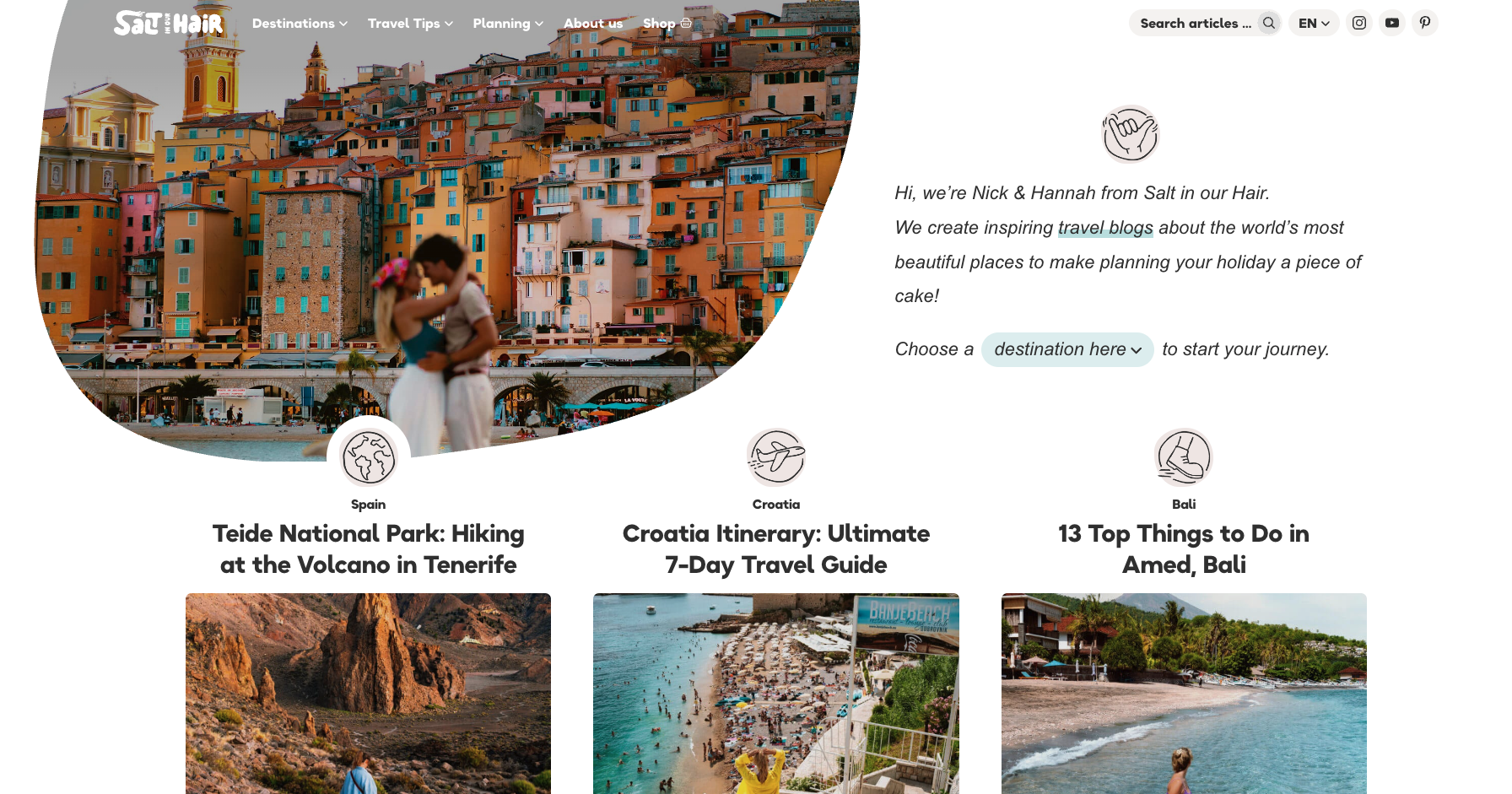 Nick and Hannah focus on sustainable travel and design-driven content. Their blog is visually stunning, and they include helpful information like travel timelines and location-specific advice, all formatted for quick reading.
Nick and Hannah focus on sustainable travel and design-driven content. Their blog is visually stunning, and they include helpful information like travel timelines and location-specific advice, all formatted for quick reading.
Feature Tip: Add interactive maps, gear checklists, or PDF downloads for itineraries. These elements keep readers on the site longer and support SEO goals.
Food Blog Examples
Food blogs succeed when they pair strong visuals with recipes people can actually follow. Clean layout, clear instructions, and helpful filters can keep users coming back.
Minimalist Baker
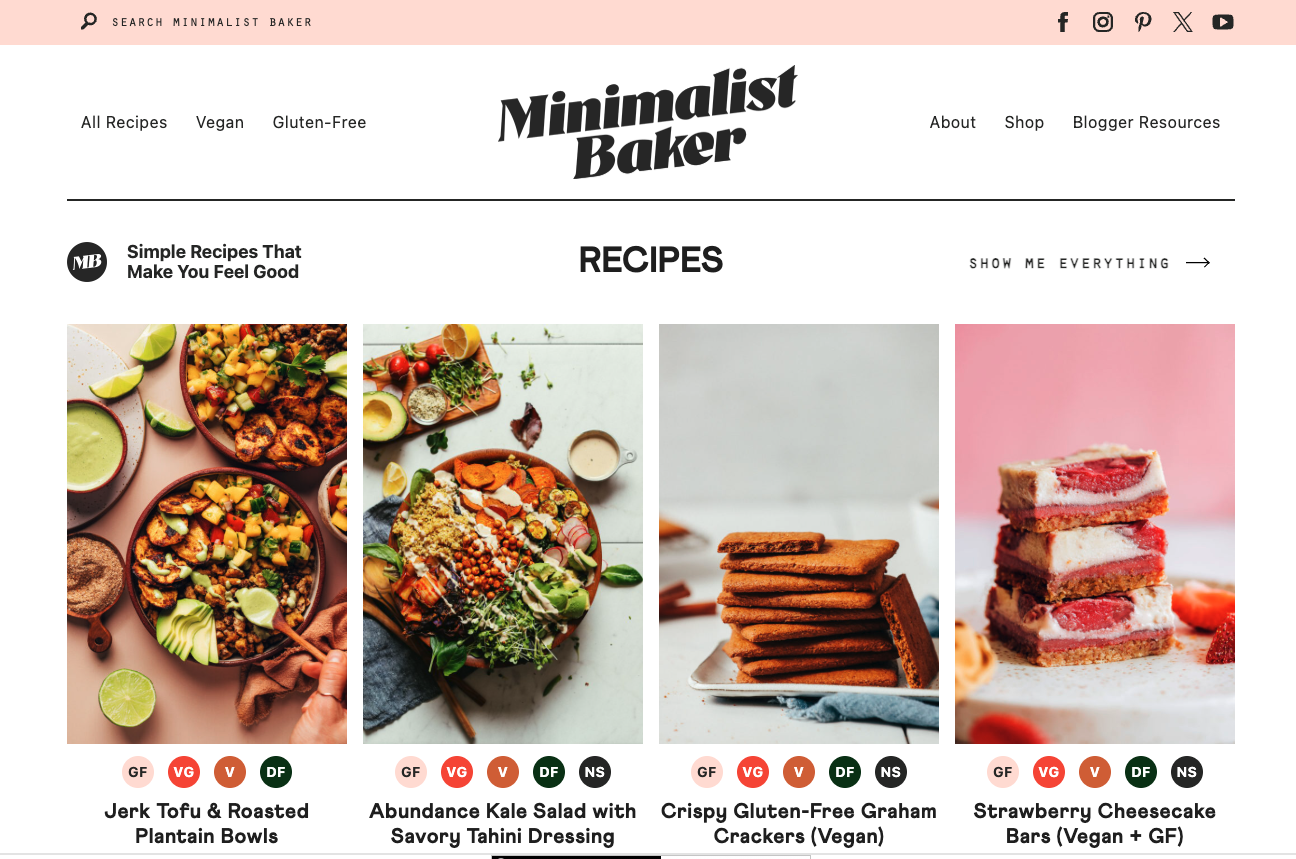
Dana Shultz keeps things simple. Her recipes usually require 10 ingredients or less and minimal equipment. The blog design mirrors that simplicity—clear images, short ingredient lists, and well-organized steps.
Pinch of Yum
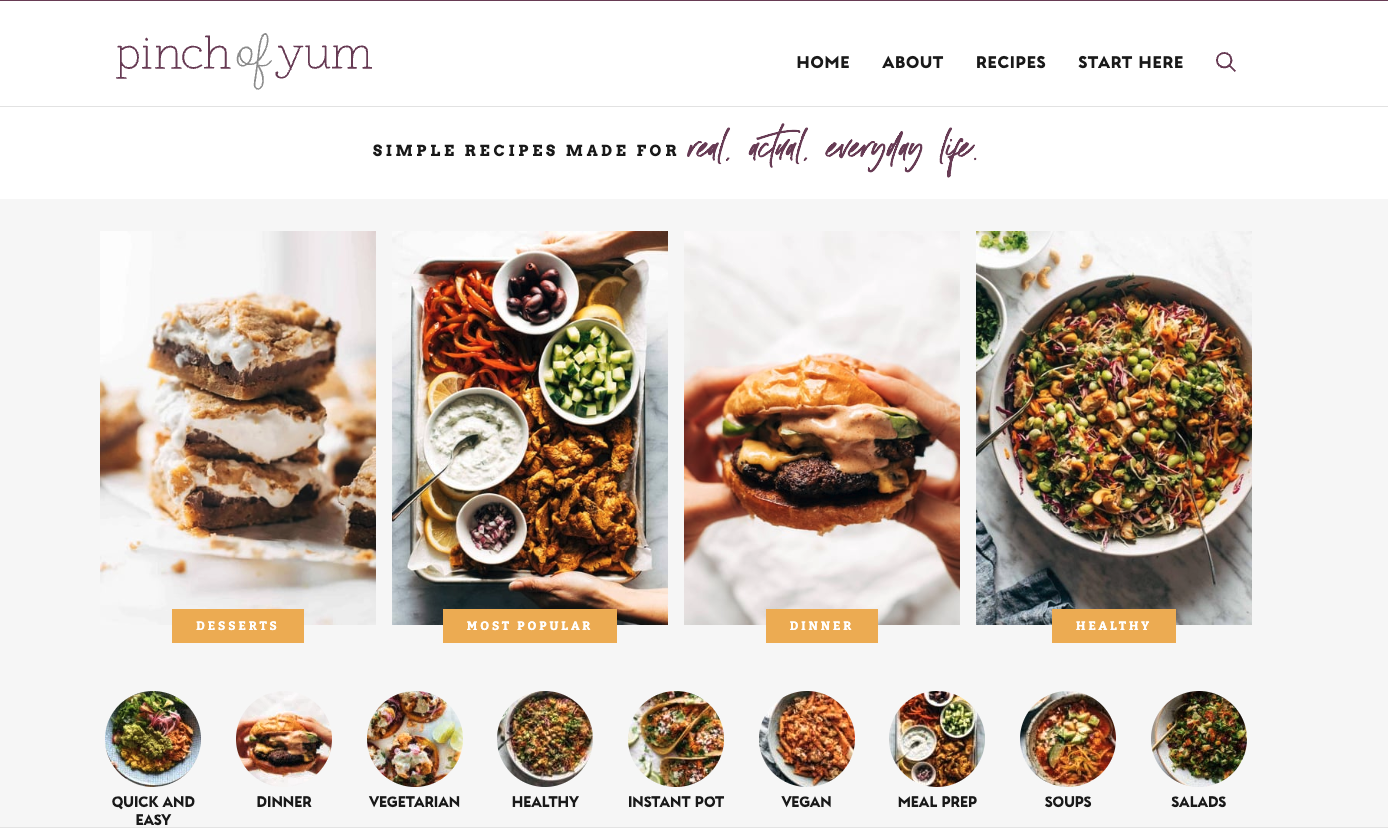 Lindsay Ostrom shares recipes that feel both homey and polished. Her posts are structured for readability, with a casual tone and step-by-step photography. She also includes personal stories, which add to the experience.
Lindsay Ostrom shares recipes that feel both homey and polished. Her posts are structured for readability, with a casual tone and step-by-step photography. She also includes personal stories, which add to the experience.
Cookie & Kate
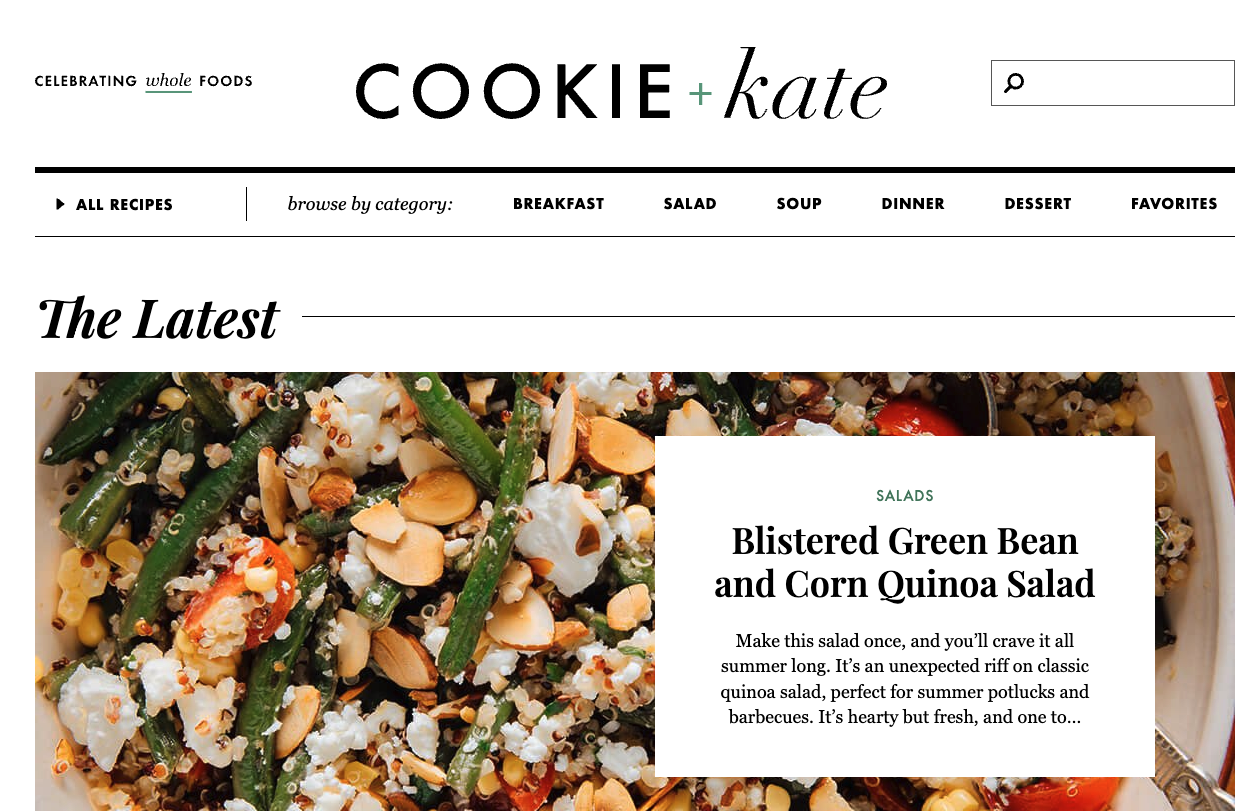 Kathryne Taylor focuses on vegetarian and whole food recipes. Her writing is friendly and informative, and she includes nutrition labels and tips for substitutions. The search and filter tools are especially helpful here.
Kathryne Taylor focuses on vegetarian and whole food recipes. Her writing is friendly and informative, and she includes nutrition labels and tips for substitutions. The search and filter tools are especially helpful here.
Not Another Cooking Show
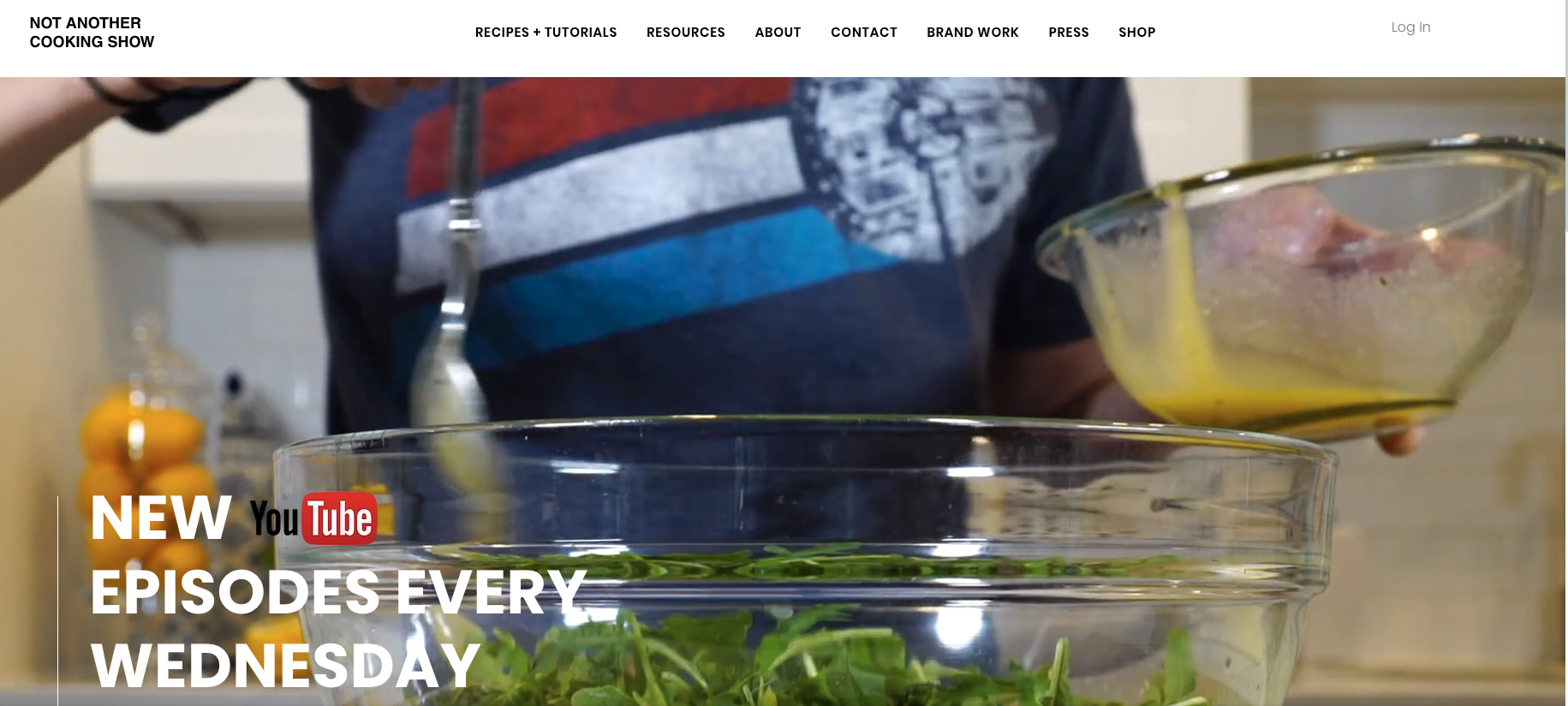 Stephen Cusato takes a video-first approach. His blog supports his YouTube content, with embedded videos and clear written instructions for each dish. He focuses on technique, which makes this site great for readers looking to get more confident in the kitchen.
Stephen Cusato takes a video-first approach. His blog supports his YouTube content, with embedded videos and clear written instructions for each dish. He focuses on technique, which makes this site great for readers looking to get more confident in the kitchen.
The Recipe Critic
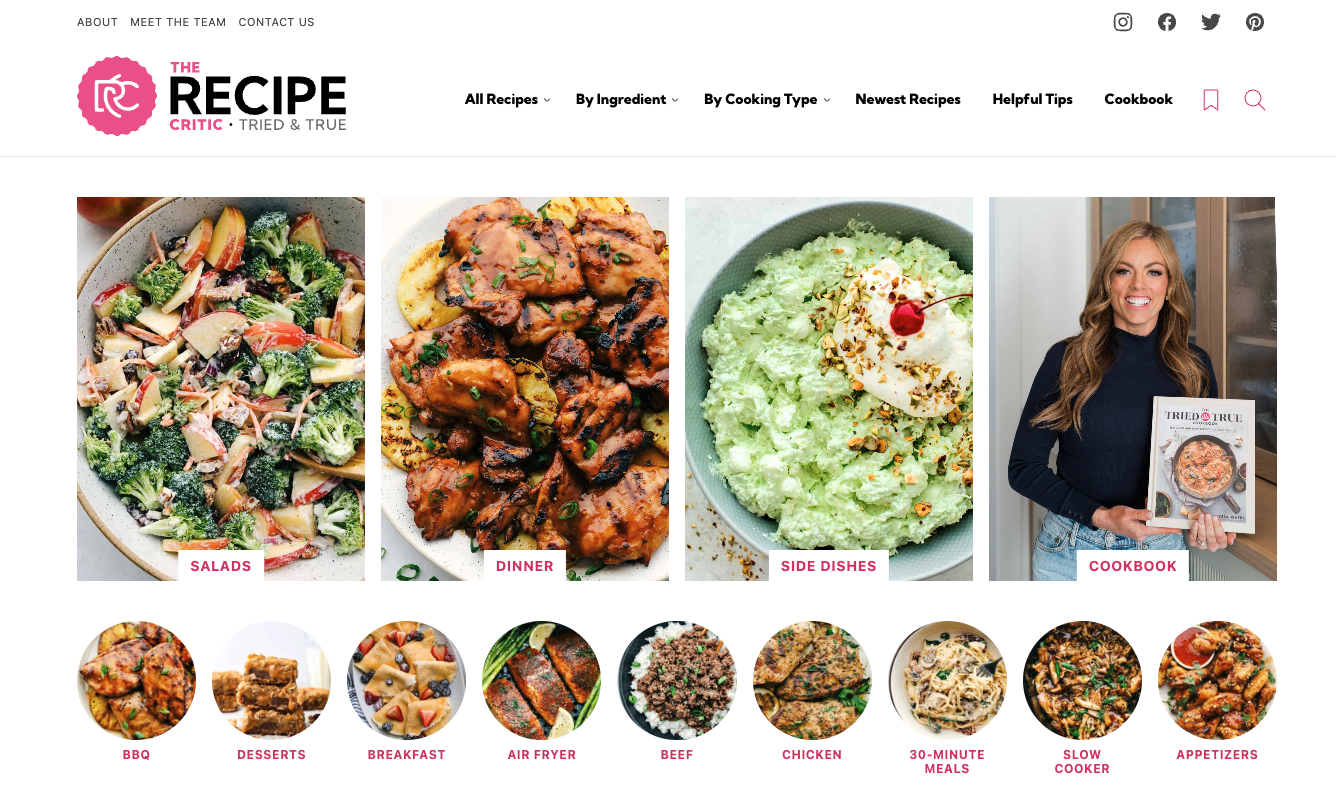 Alyssa Rivers provides recipes that cater to busy families. Her blog includes filters by cooking method (slow cooker, air fryer, etc.), and the design makes it easy to search by ingredient or occasion. Readers can quickly find what they need and get cooking.
Alyssa Rivers provides recipes that cater to busy families. Her blog includes filters by cooking method (slow cooker, air fryer, etc.), and the design makes it easy to search by ingredient or occasion. Readers can quickly find what they need and get cooking.
Usability Tip: Add jump links to recipe sections, filters for dietary needs (e.g., gluten-free, dairy-free), and a print button. These blog features improve the experience, especially for mobile users.
Fashion and Beauty Blog Examples
Fashion and beauty blogs do well when they blend strong photography, consistent style, and a clear point of view. Many of these blogs also drive revenue through brand collaborations or curated shop pages.
The Blonde Salad
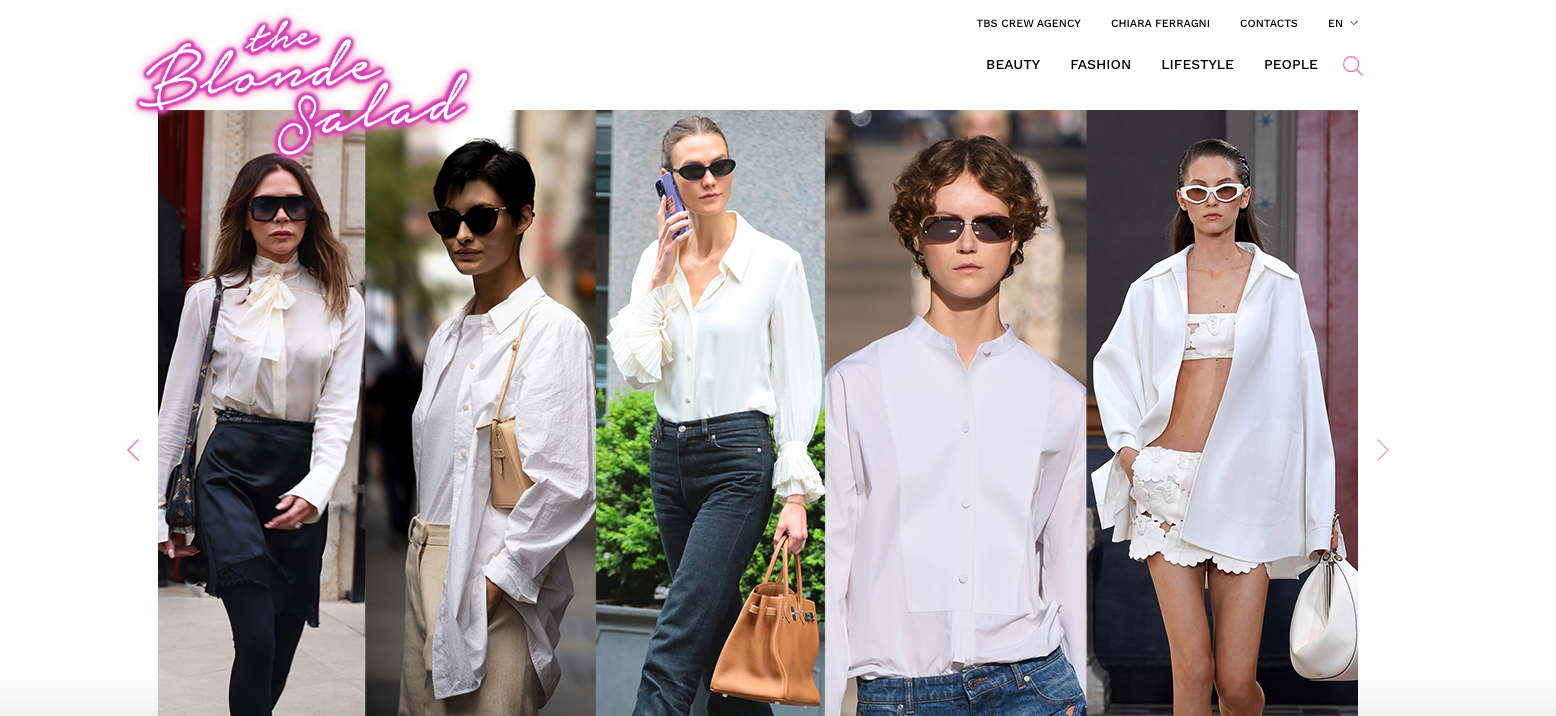 Founded by Chiara Ferragni, this blog helped define influencer culture. It mixes fashion editorial with lifestyle content, and while it’s grown into a brand, it still keeps a blog-style format. It’s a strong example of how consistent visuals and personal style can build a massive following.
Founded by Chiara Ferragni, this blog helped define influencer culture. It mixes fashion editorial with lifestyle content, and while it’s grown into a brand, it still keeps a blog-style format. It’s a strong example of how consistent visuals and personal style can build a massive following.
Fashion Jackson
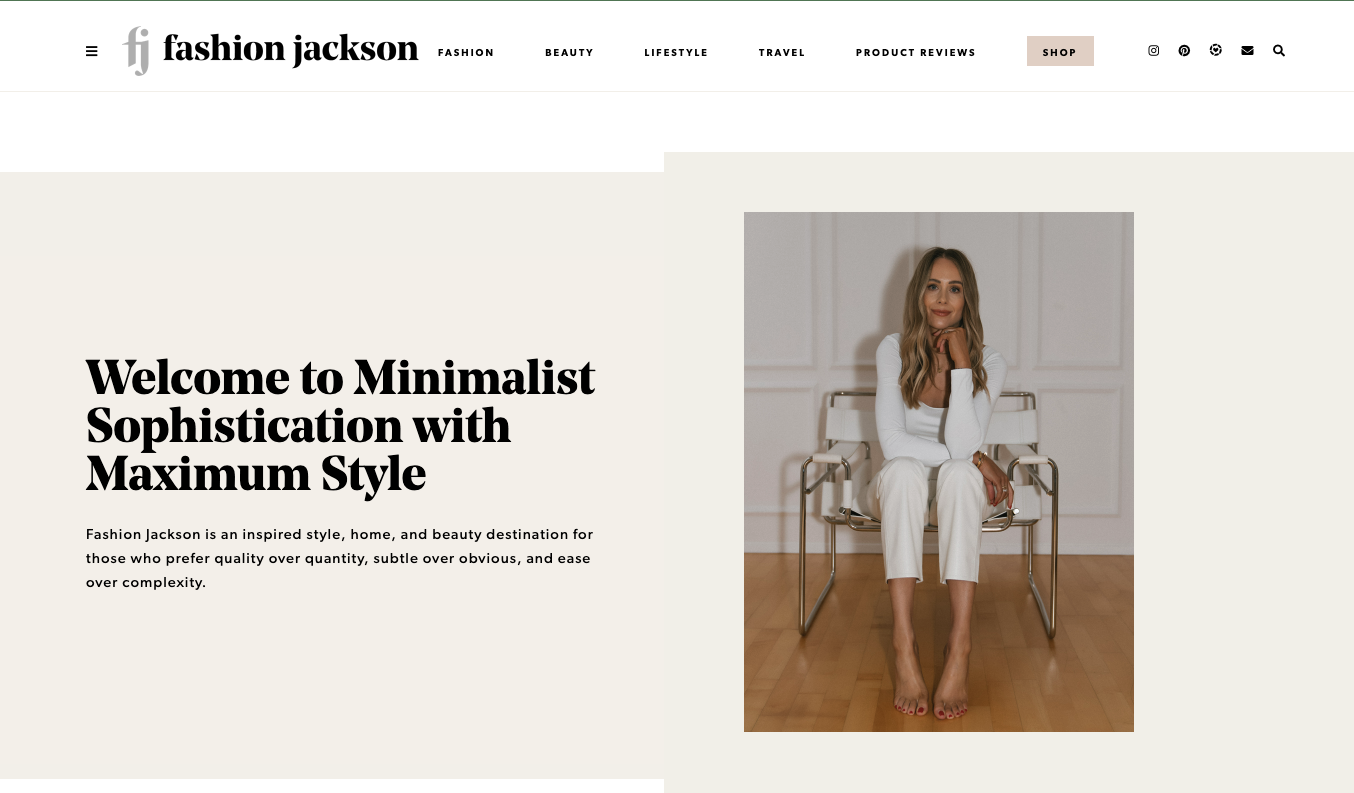 Amy Jackson shares minimalist, everyday fashion that’s easy to replicate. Her layout is clean, with regular outfit breakdowns and shopping links. She also uses a “Dailies” feature to show off simple looks, home items, and more in a fast-scroll format.
Amy Jackson shares minimalist, everyday fashion that’s easy to replicate. Her layout is clean, with regular outfit breakdowns and shopping links. She also uses a “Dailies” feature to show off simple looks, home items, and more in a fast-scroll format.
One Magazine
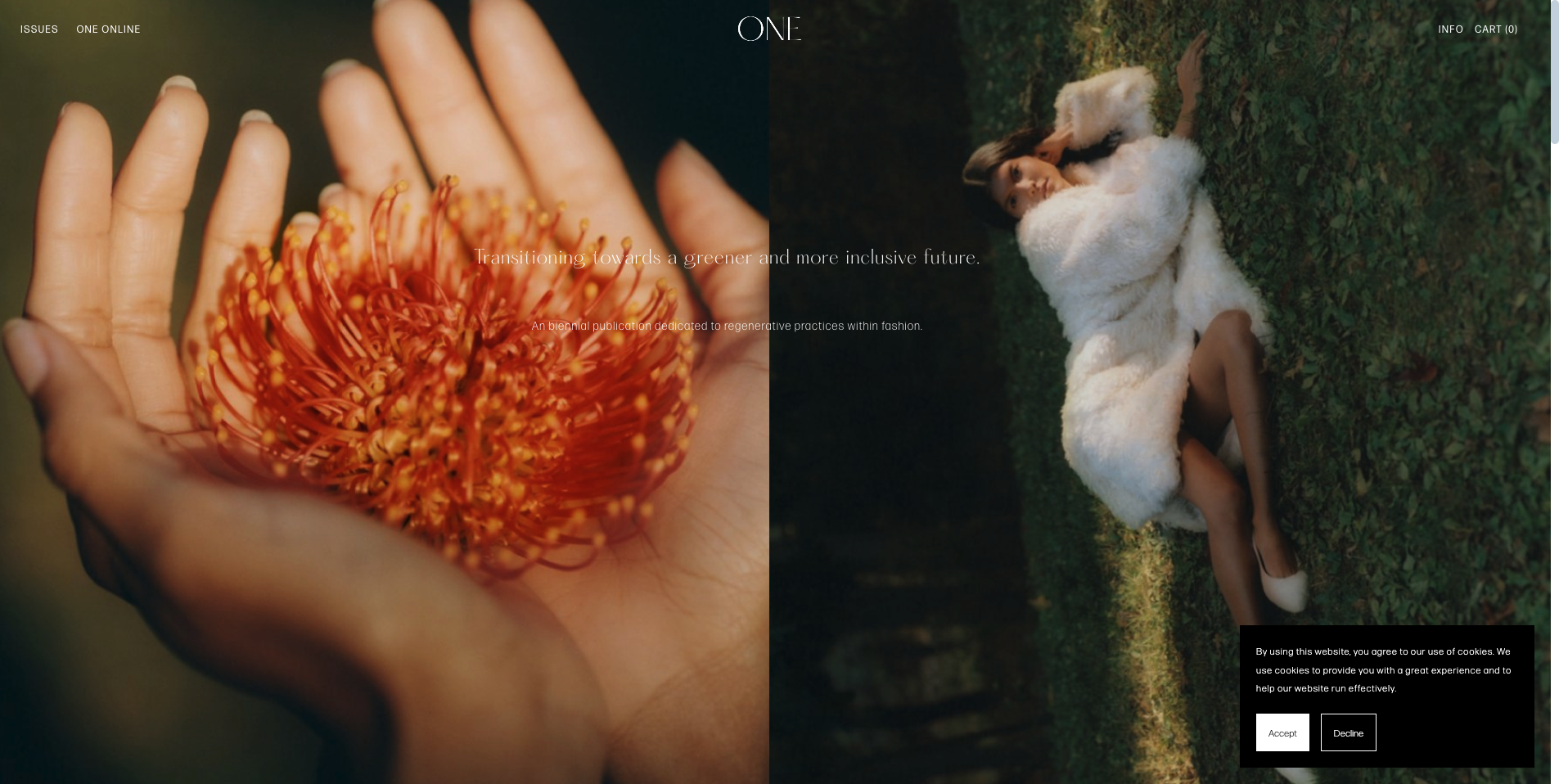 This site balances fashion and sustainability with an editorial feel. It covers emerging designers and eco-conscious products. What sets it apart is the bold photography paired with thoughtful, short-form writing.
This site balances fashion and sustainability with an editorial feel. It covers emerging designers and eco-conscious products. What sets it apart is the bold photography paired with thoughtful, short-form writing.
He Spoke Style
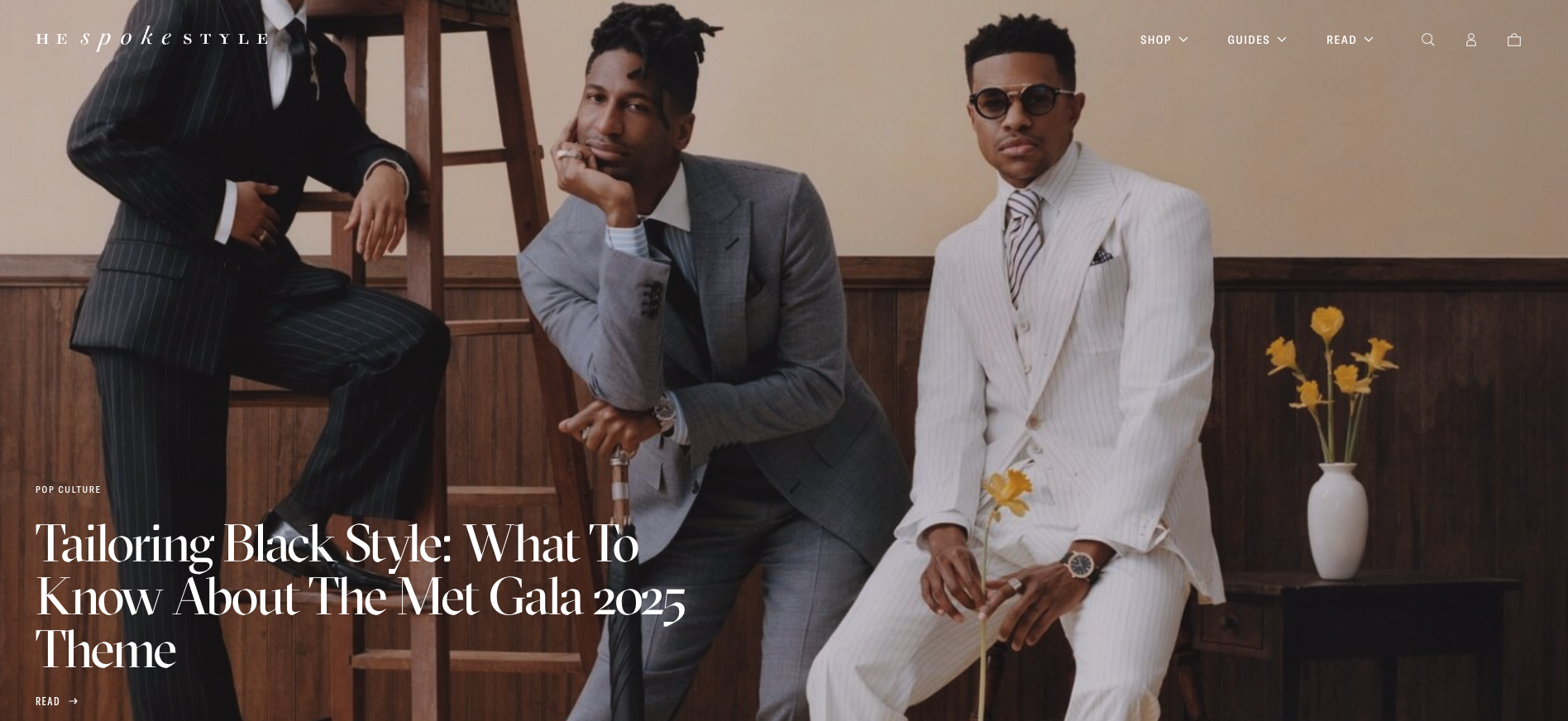 Brian Sacawa’s blog is a standout in men’s fashion. He combines style guides with content on grooming, cigars, watches, and whiskey. It’s informative without being overwhelming, and his tone appeals to readers looking for both style and substance.
Brian Sacawa’s blog is a standout in men’s fashion. He combines style guides with content on grooming, cigars, watches, and whiskey. It’s informative without being overwhelming, and his tone appeals to readers looking for both style and substance.
Kelly Augustine
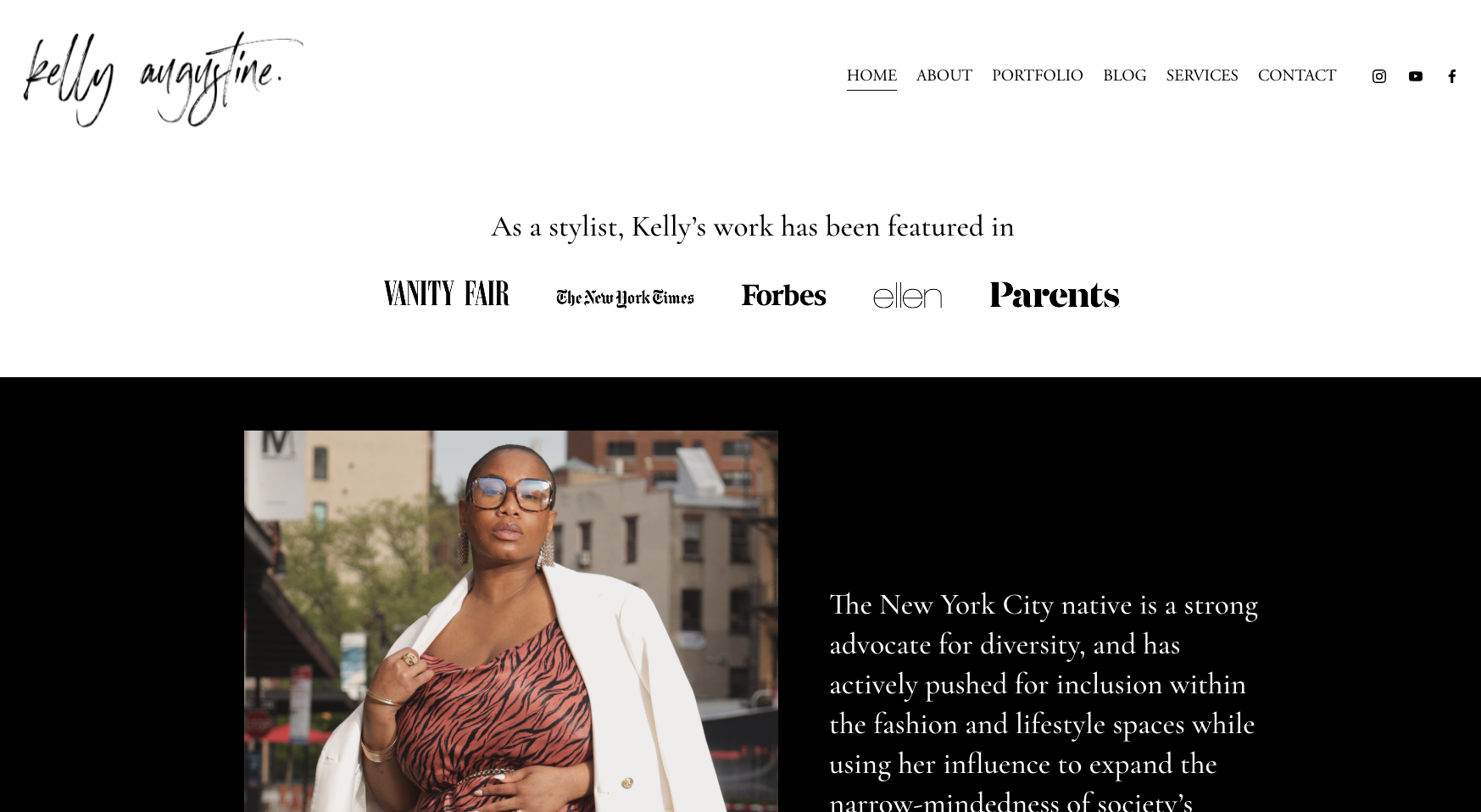 Kelly writes about plus-size fashion, beauty, and lifestyle. Her posts feel honest and self-assured, and her styling tips help fill a gap in a space that often overlooks diverse body types. Her site is both editorial and personal—something many readers connect with.
Kelly writes about plus-size fashion, beauty, and lifestyle. Her posts feel honest and self-assured, and her styling tips help fill a gap in a space that often overlooks diverse body types. Her site is both editorial and personal—something many readers connect with.
Content Tip: Link to outfit pieces or product pages right under your images. It saves readers time and increases click-throughs.
Health and Fitness Blog Examples
These blogs focus on well-being, workouts, nutrition, and sometimes mental health. Readers often connect with the person behind the posts, especially when transformation or personal growth is a theme.
The Fitnessista
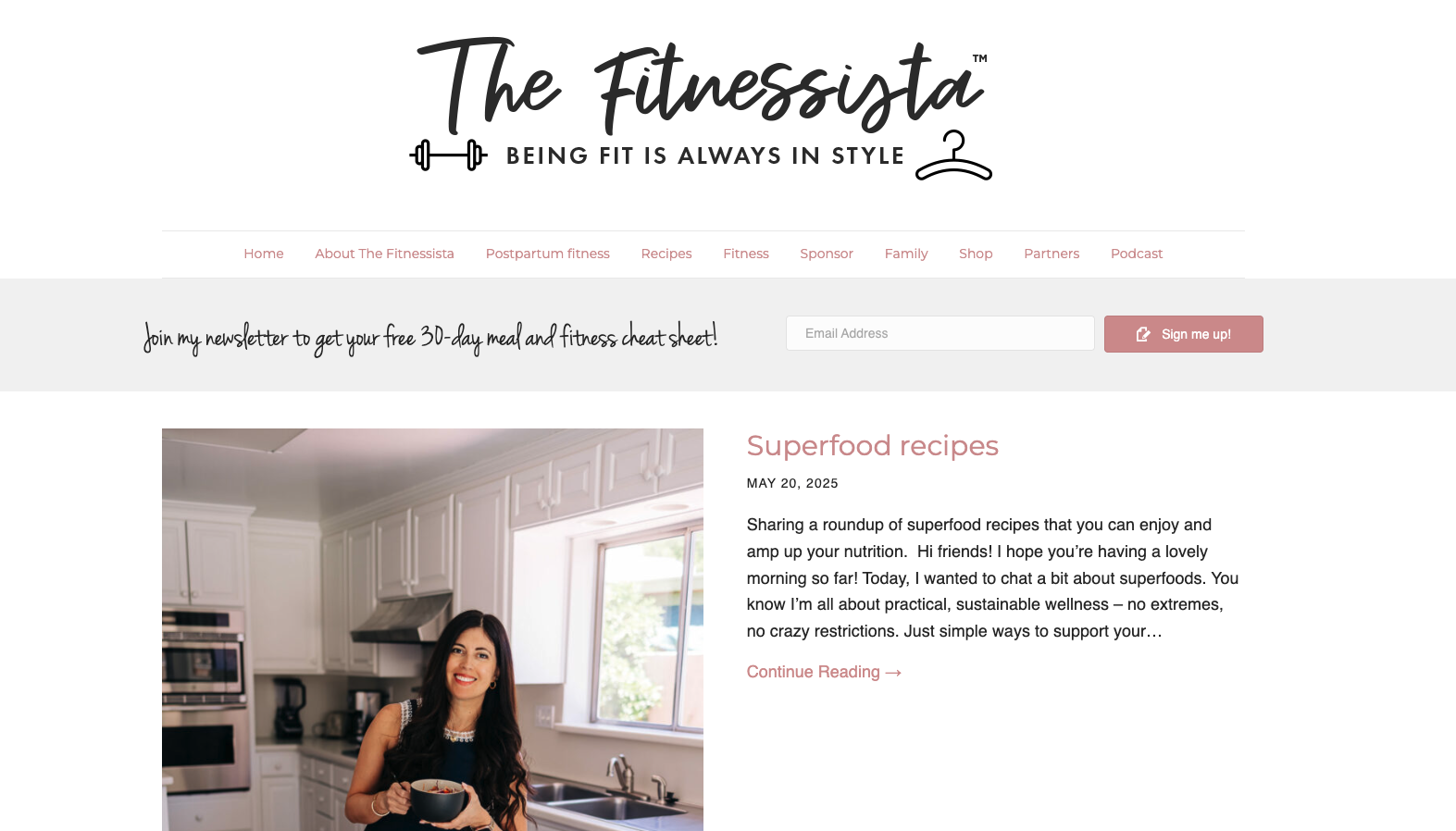 Gina Harney shares workouts, recipes, and wellness advice. Her posts blend fitness content with lifestyle elements like motherhood and personal development routines. She also runs coaching and courses, which help build trust with her audience.
Gina Harney shares workouts, recipes, and wellness advice. Her posts blend fitness content with lifestyle elements like motherhood and personal development routines. She also runs coaching and courses, which help build trust with her audience.
Nerd Fitness
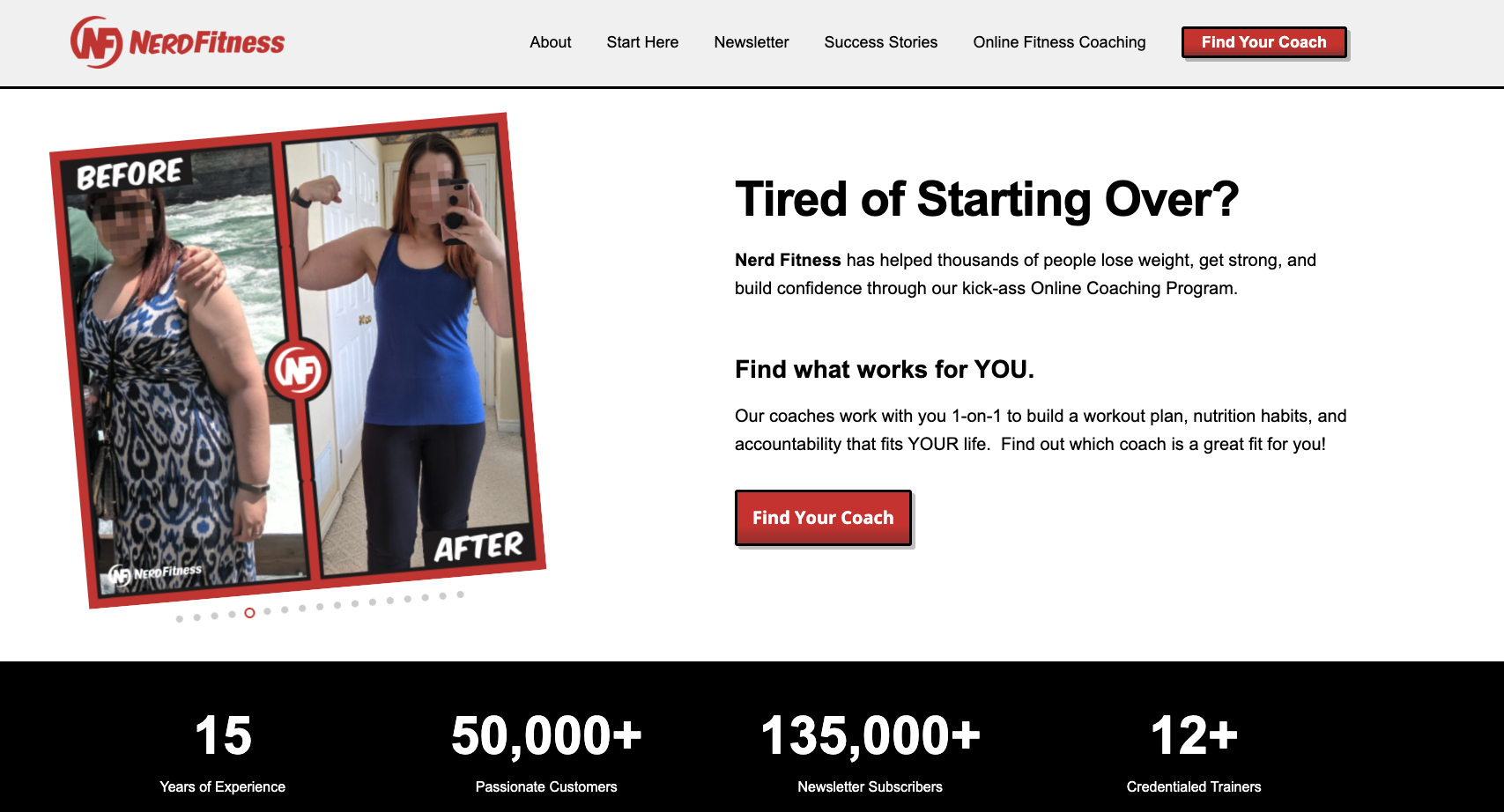 This blog targets readers who love pop culture but want to get healthier. Steve Kamb writes about fitness in a friendly, casual way, using themes from video games and comics. The site also has a strong online community element and a focus on sustainable habits.
This blog targets readers who love pop culture but want to get healthier. Steve Kamb writes about fitness in a friendly, casual way, using themes from video games and comics. The site also has a strong online community element and a focus on sustainable habits.
Fit Bottomed Girls
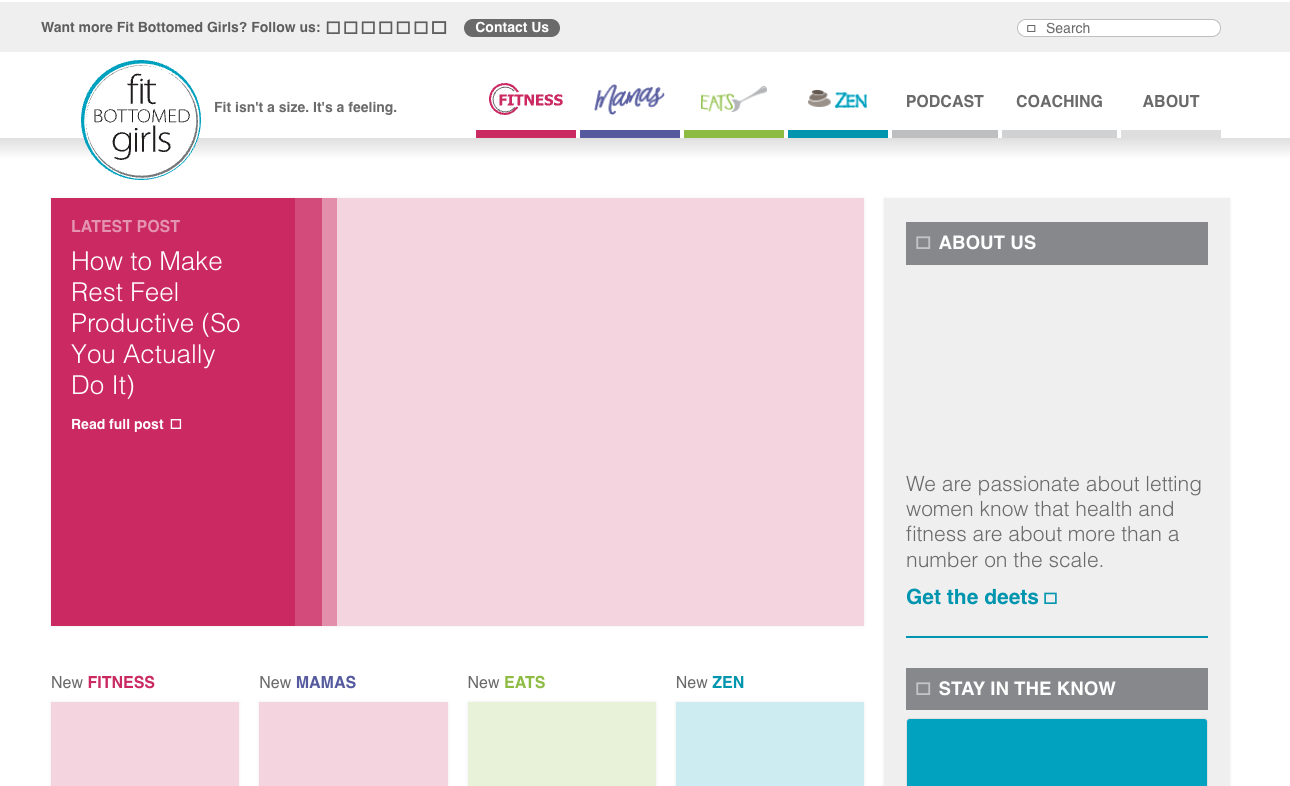
Founded by Jenn Walters and Kristen Seymour, this blog covers health, fitness, self-care, and body image. Their tone is inclusive and judgment-free, which draws in readers tired of the usual “fitness grind” approach.
Mindbodygreen
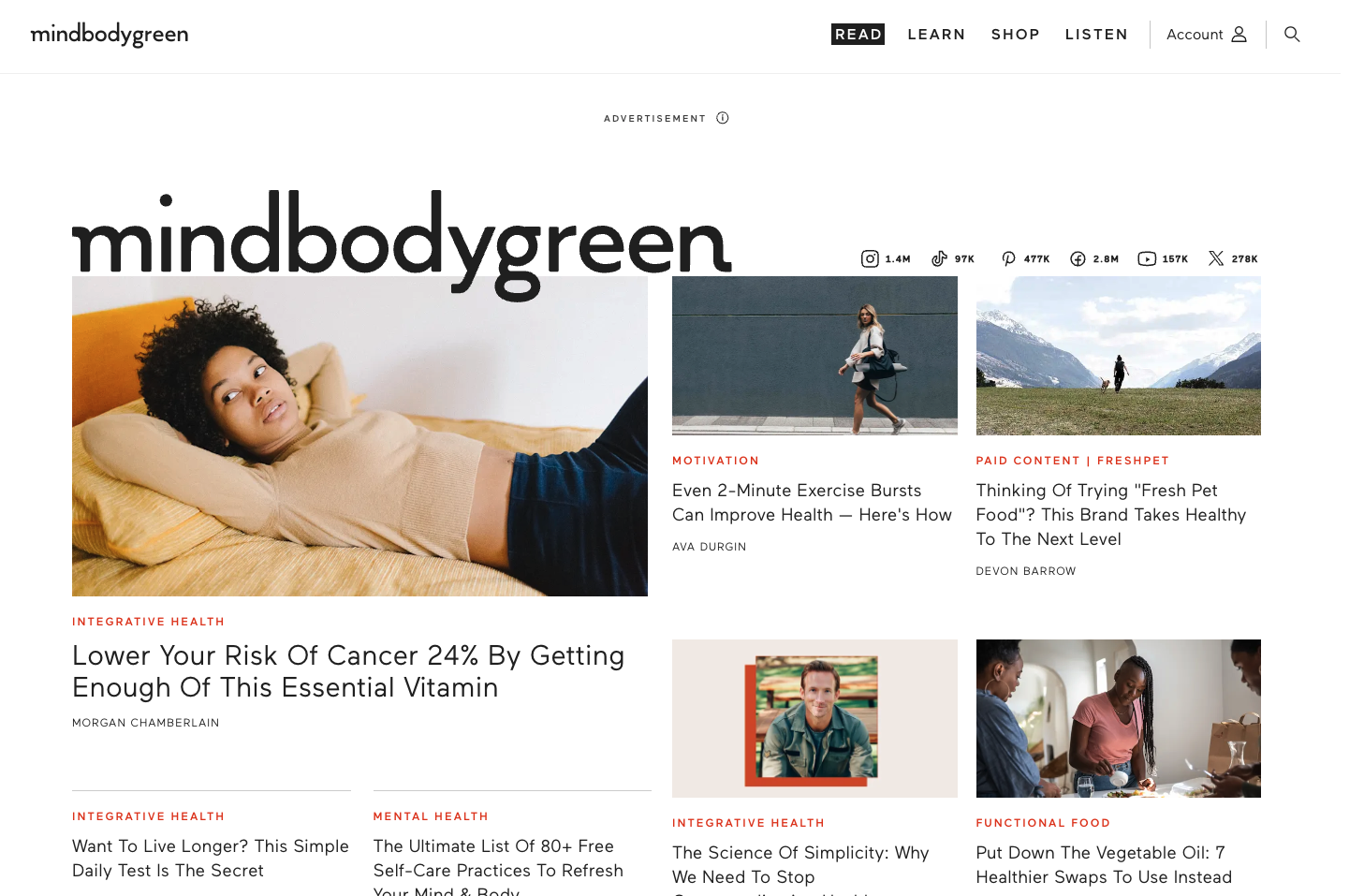 This site features expert-written articles on nutrition, mental wellness, clean beauty, and fitness blogs. It feels like a digital magazine with a focus on balance and holistic living. The topics are science-based, with strong editorial standards.
This site features expert-written articles on nutrition, mental wellness, clean beauty, and fitness blogs. It feels like a digital magazine with a focus on balance and holistic living. The topics are science-based, with strong editorial standards.
Mrs. Space Cadet
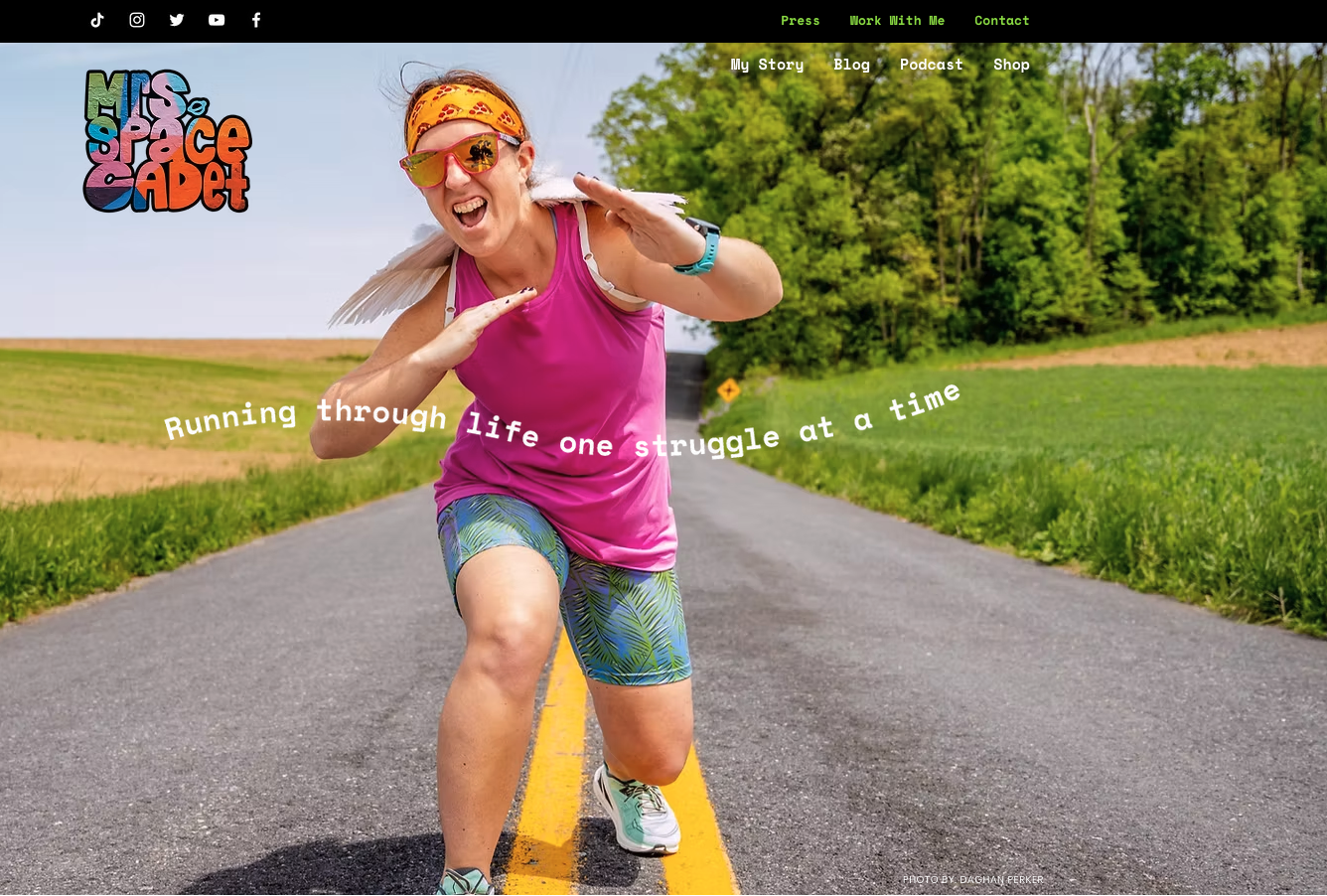 Erin Azar shares her running journey as someone who doesn’t “look” like a typical runner. Her blog and social media show the real ups and downs of training. Her content is funny, honest, and incredibly motivating for beginners.
Erin Azar shares her running journey as someone who doesn’t “look” like a typical runner. Her blog and social media show the real ups and downs of training. Her content is funny, honest, and incredibly motivating for beginners.
Format Idea: In your fitness blog, add voice, audio clips, or embedded YouTube videos to show personality and build a stronger connection with your audience.
Parenting and Kid Activity Blogs
These blogs thrive on honesty, tips that work in real life, and a tone that feels supportive—not preachy. Many also include printables, schedules, and checklists to make parents’ lives easier.
Busy Toddler
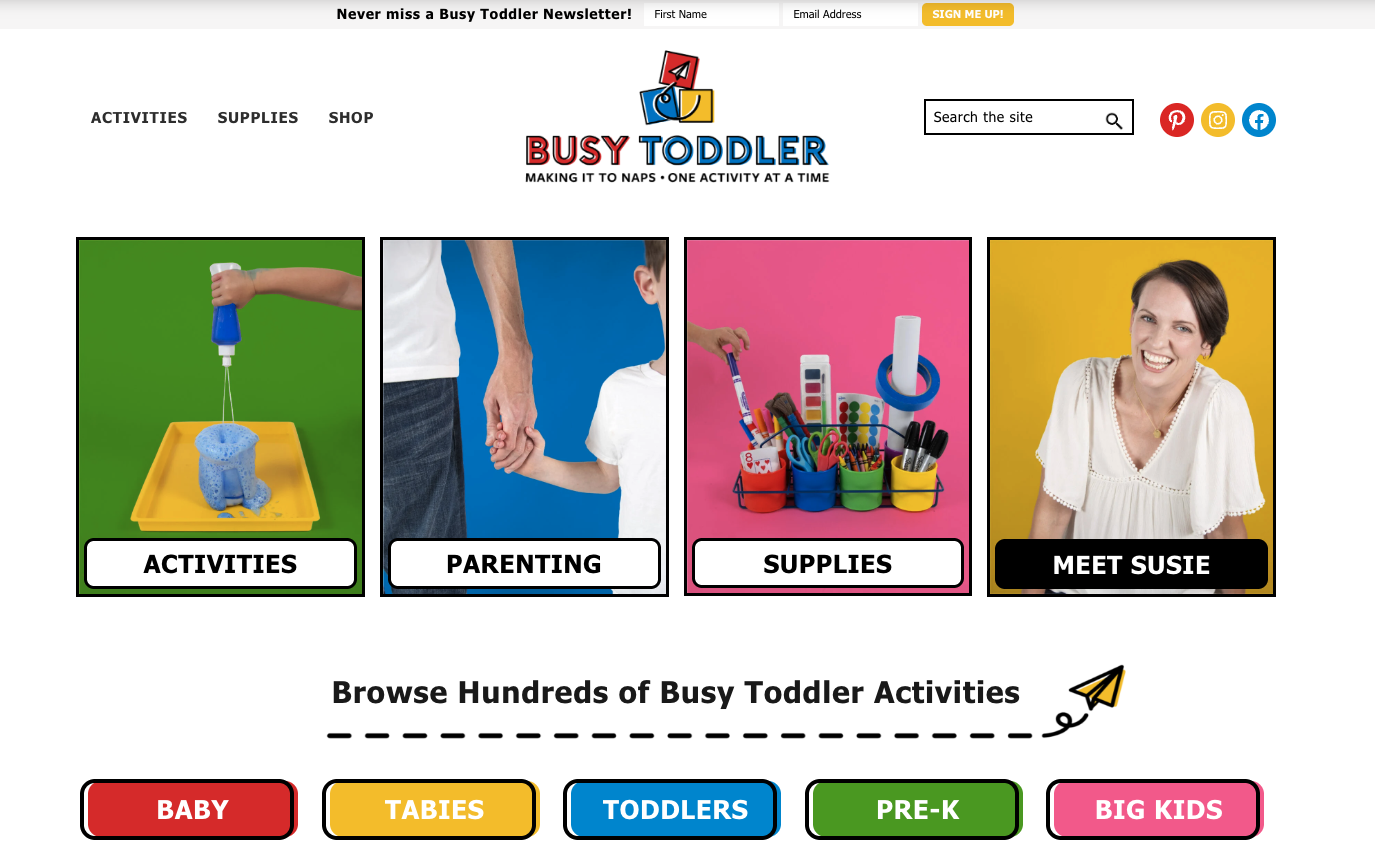 Susie Allison’s professional blog is packed with play-based learning activities. Her posts go viral because they’re simple, low-prep, and actually work. The clean design and image-led format make the ideas easy to follow.
Susie Allison’s professional blog is packed with play-based learning activities. Her posts go viral because they’re simple, low-prep, and actually work. The clean design and image-led format make the ideas easy to follow.
Mom Boss Life
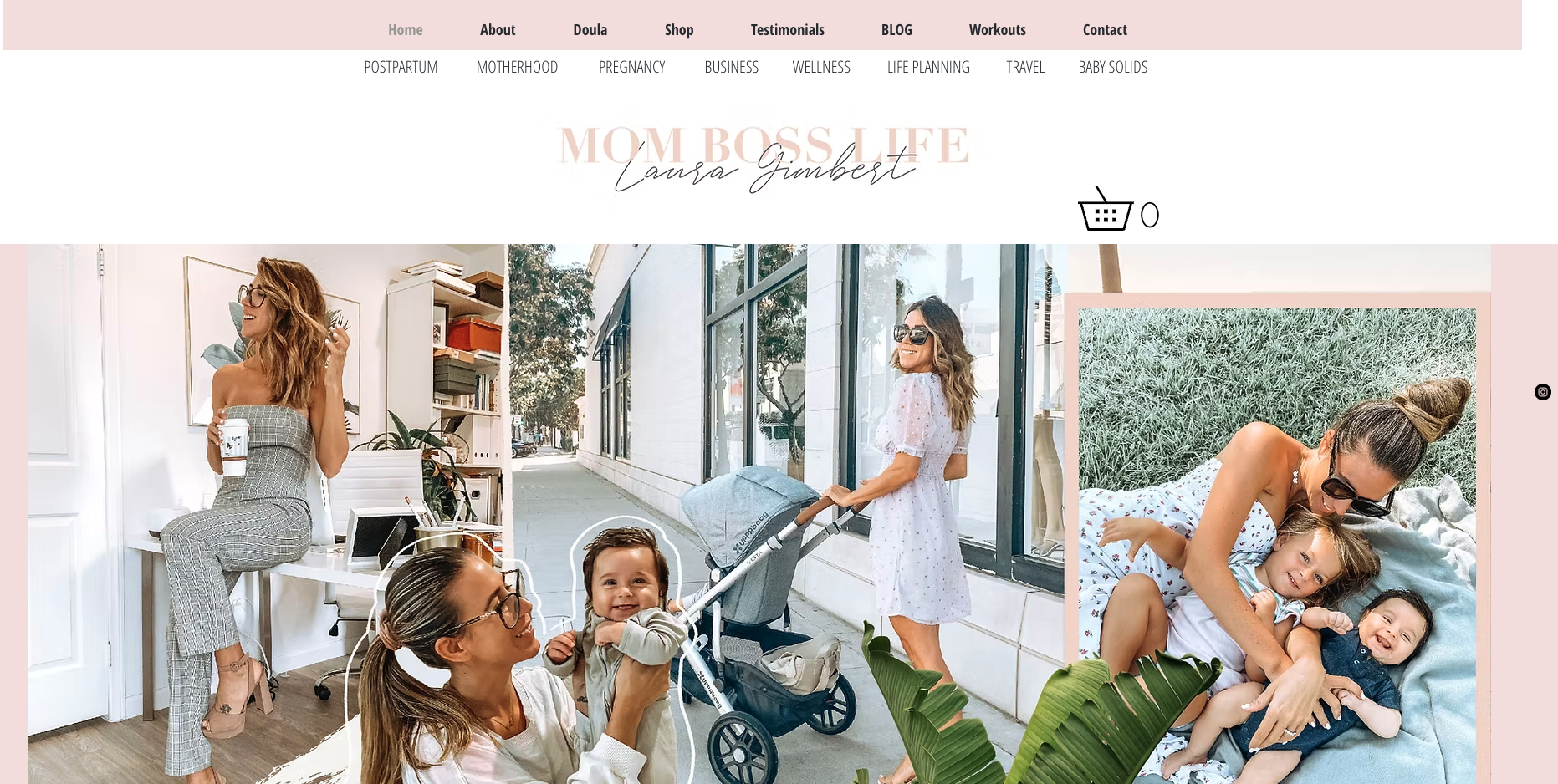 Laura Gimbert blends motherhood with business-building tips. Her blog shows how to juggle both without losing your mind. Readers appreciate the mix of productivity hacks, mindset advice, and mom life stories.
Laura Gimbert blends motherhood with business-building tips. Her blog shows how to juggle both without losing your mind. Readers appreciate the mix of productivity hacks, mindset advice, and mom life stories.
Add-On Idea: Offer email signups in exchange for printables—things like routine checklists, screen-time trackers, or weekly planners.
Home, DIY, and Interior Design Blog Examples
These blogs do well when they offer real projects, clear photos, and how-to breakdowns that don’t feel out of reach. The mix of storytelling and visual structure is key.
The Harper House
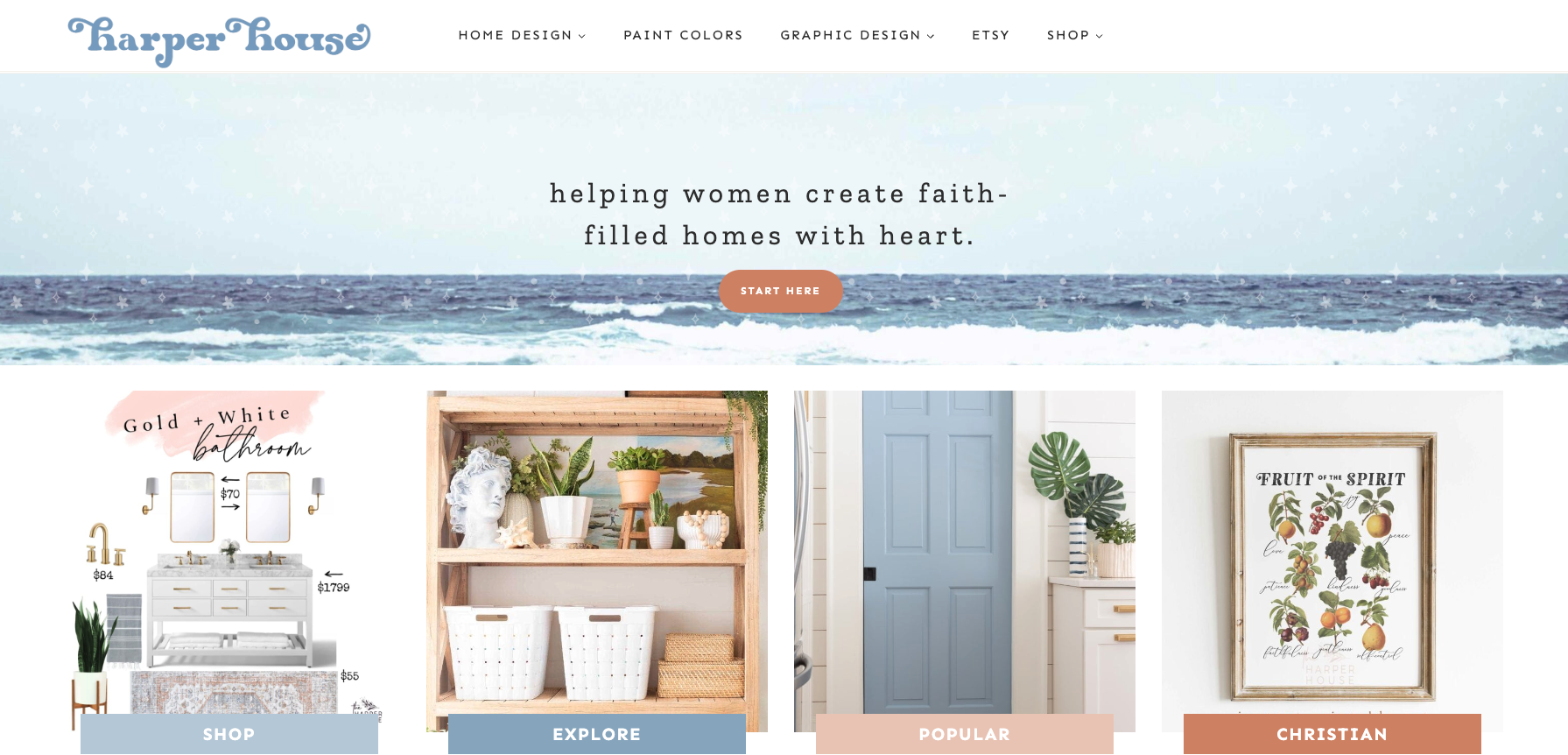 Christy shares full renovation projects with detailed guides, budget tips, and behind-the-scenes updates. Her content feels like HGTV meets a personal blog. It’s helpful for readers looking to remodel or flip homes with a hands-on approach.
Christy shares full renovation projects with detailed guides, budget tips, and behind-the-scenes updates. Her content feels like HGTV meets a personal blog. It’s helpful for readers looking to remodel or flip homes with a hands-on approach.
Pretty Handy Girl
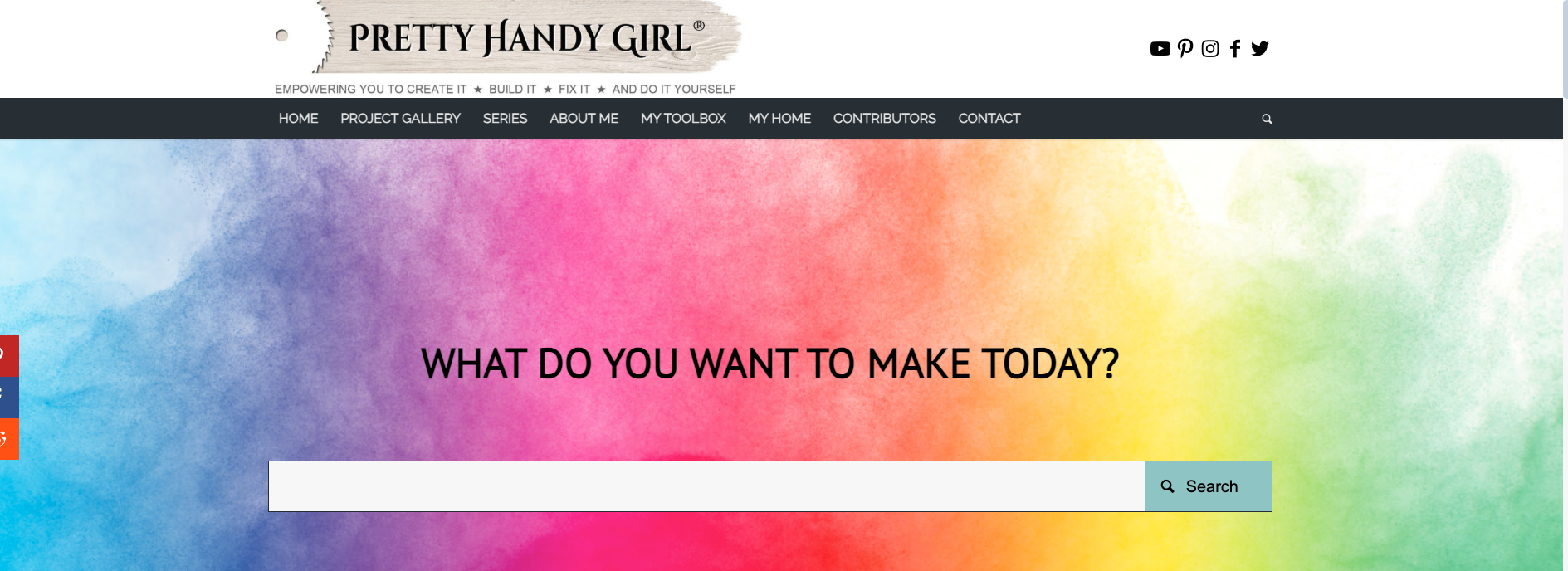 Brittany keeps her site focused on empowering women to use tools, tackle repairs, and build furniture. Tutorials are broken into easy steps with photos and supply lists. She also covers decorating and seasonal crafts, which gives the blog range without losing focus.
Brittany keeps her site focused on empowering women to use tools, tackle repairs, and build furniture. Tutorials are broken into easy steps with photos and supply lists. She also covers decorating and seasonal crafts, which gives the blog range without losing focus.
The Inspired Room
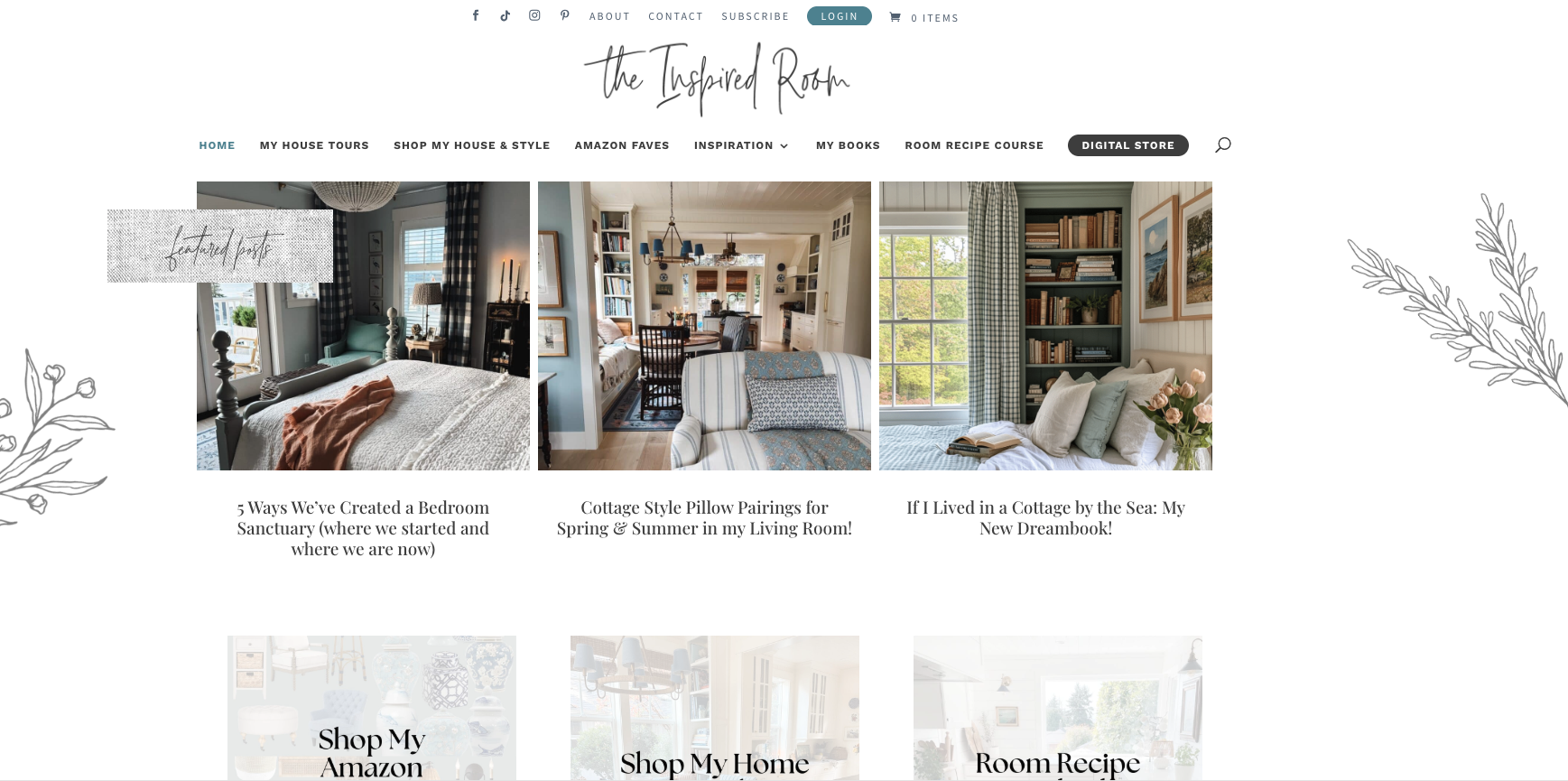 Melissa Michaels blends interior design with gentle lifestyle content. Her blog layout is light and uncluttered, just like her style advice. She writes about creating calm, comfortable spaces—no trends, just livable ideas. It’s especially good for readers drawn to cozy over flashy.
Melissa Michaels blends interior design with gentle lifestyle content. Her blog layout is light and uncluttered, just like her style advice. She writes about creating calm, comfortable spaces—no trends, just livable ideas. It’s especially good for readers drawn to cozy over flashy.
Pheasant Run
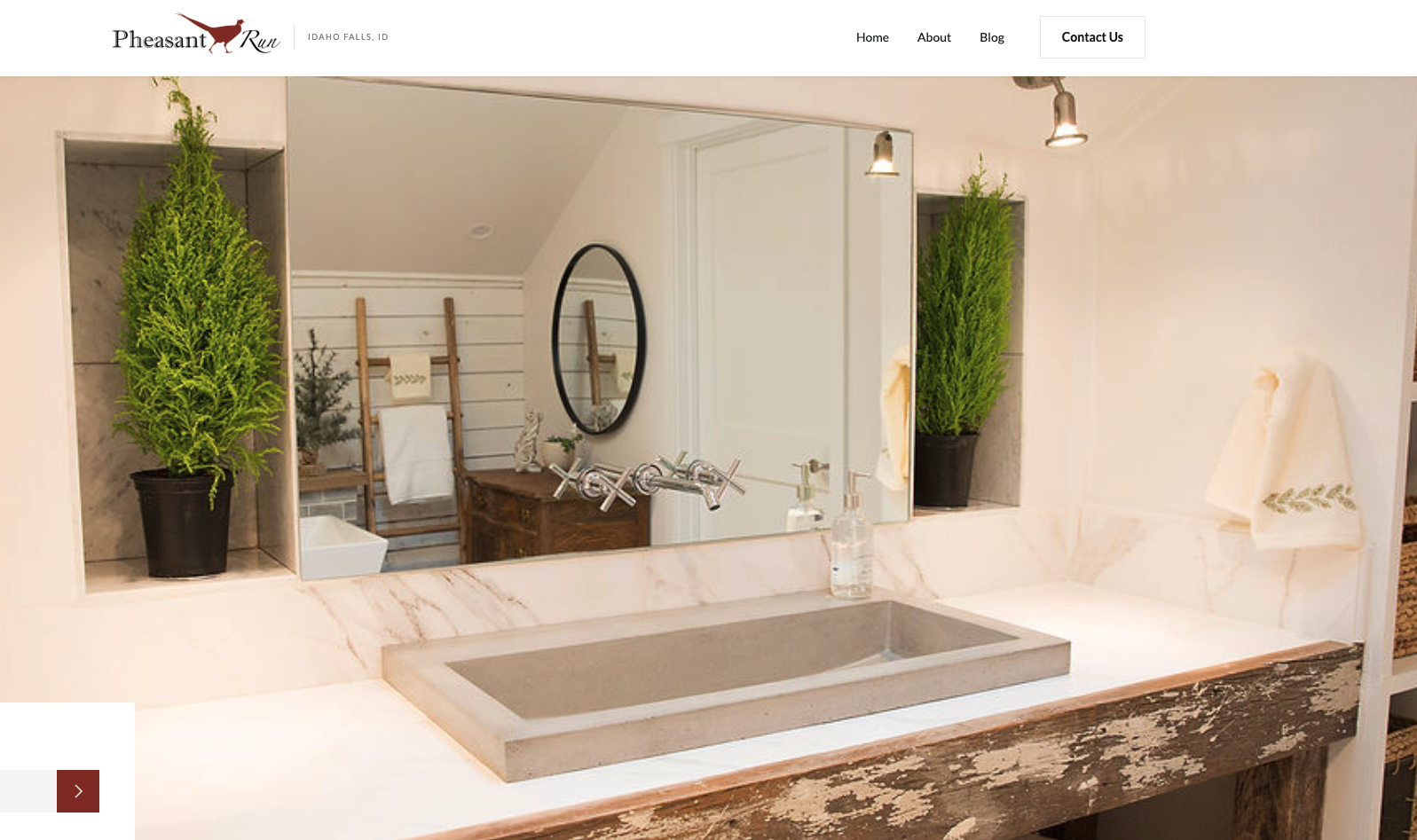 Kris Smith brings a farmhouse feel with personal posts about decorating, DIY projects, and family life. It’s a mix of rustic style and practicality. Her writing feels like advice from a neighbor who just happens to have great taste.
Kris Smith brings a farmhouse feel with personal posts about decorating, DIY projects, and family life. It’s a mix of rustic style and practicality. Her writing feels like advice from a neighbor who just happens to have great taste.
The House That Lars Built
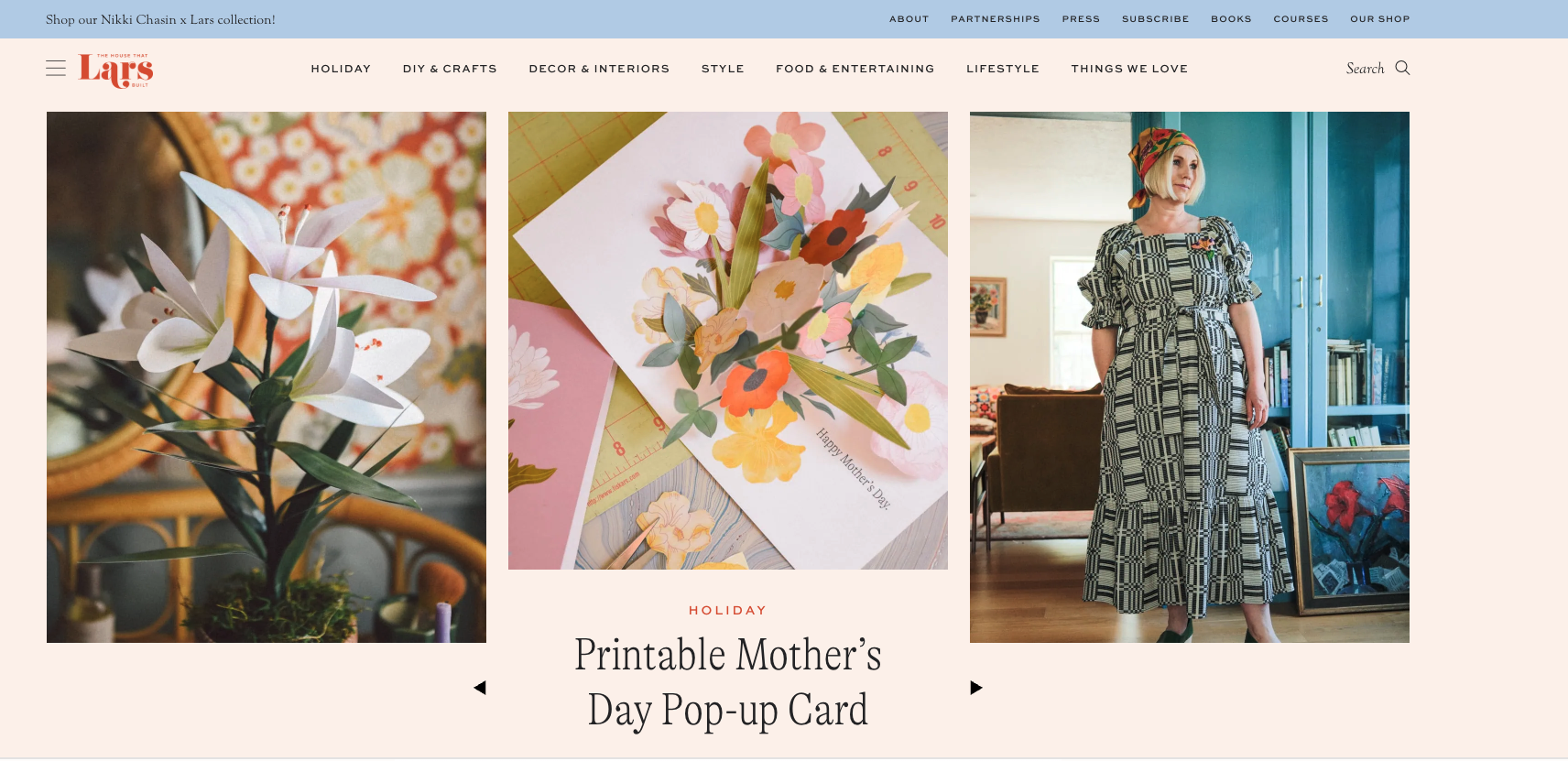 Brittany Jepsen combines art and home décor in bold, colorful ways. Her site is packed with DIYs that lean heavily into crafts, design, and celebration (think paper flower installations or themed party setups). It stands out because of its creative direction and visual identity.
Brittany Jepsen combines art and home décor in bold, colorful ways. Her site is packed with DIYs that lean heavily into crafts, design, and celebration (think paper flower installations or themed party setups). It stands out because of its creative direction and visual identity.
Design Tip: Use a sticky category filter at the top of your blog—like Kitchen, Outdoor, or Rental-Friendly—to help readers sort through your content quickly without losing their place.
Business, Marketing, and Technology Best Blog Examples
These blogs focus on clarity, structure, and reliable content. They succeed when they consistently publish articles that solve real problems, explain complex topics in plain terms, and provide proof-backed advice.
Ahrefs Blog
Known for detailed SEO and digital marketing guides. Posts are usually long-form, packed with examples, screenshots, and real numbers. Whether it’s keyword research or link building, the writing always speaks to both beginners and pros.
Benedict Evans
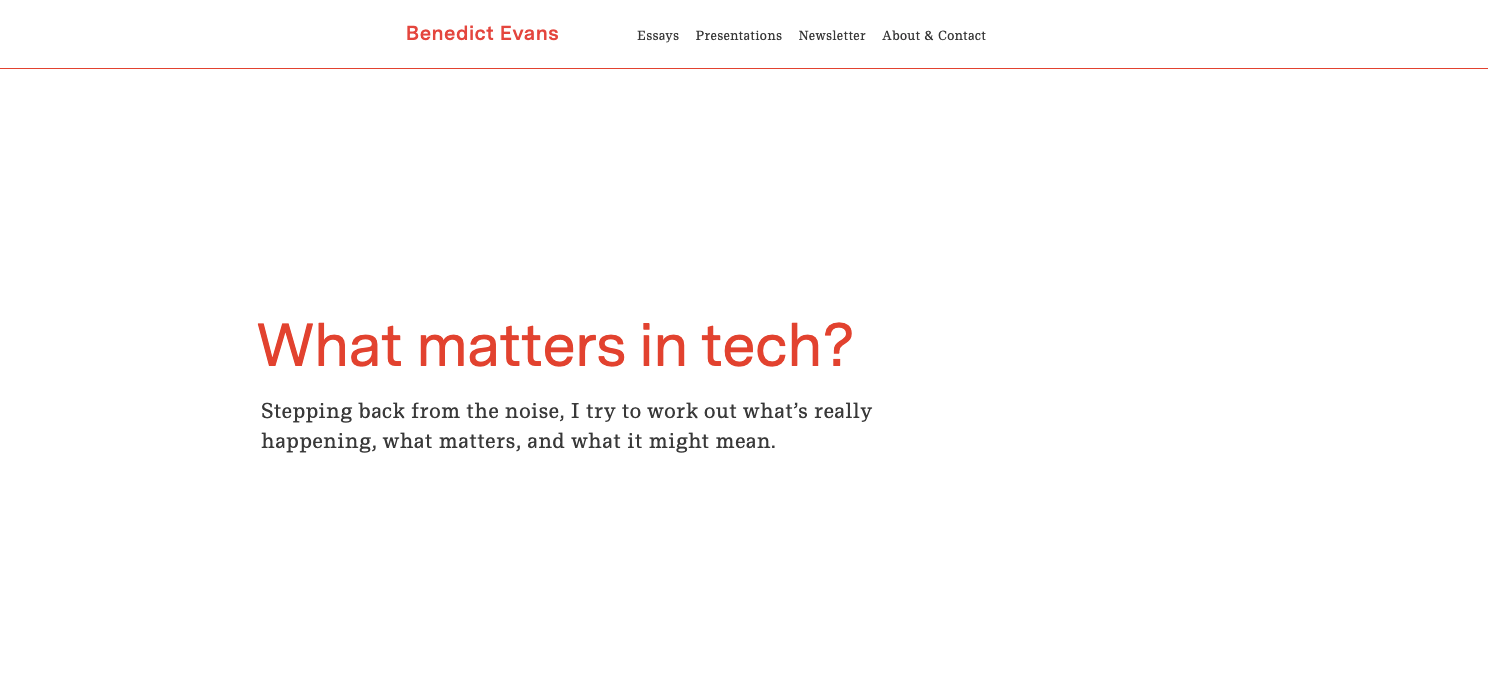 A clean, minimalist blog covering tech industry shifts, trends, and big-picture strategy. Benedict writes with depth, but without fluff. Posts are short enough to read on a break but dense enough to bookmark and revisit.
A clean, minimalist blog covering tech industry shifts, trends, and big-picture strategy. Benedict writes with depth, but without fluff. Posts are short enough to read on a break but dense enough to bookmark and revisit.
Stratechery
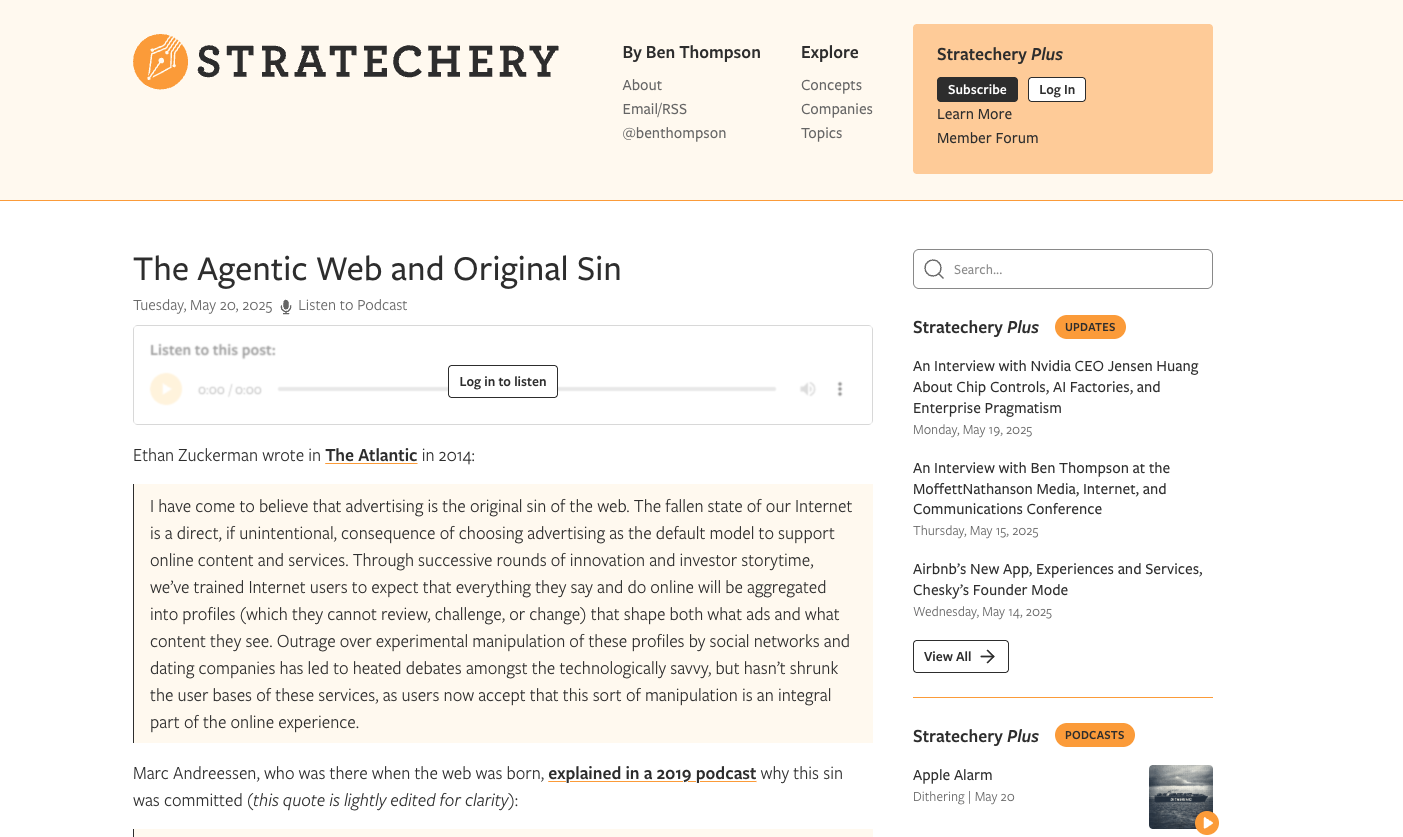 Ben Thompson’s subscriber-supported blog analyzes tech and business strategy, often through case studies and market trends. Content is delivered through written articles and newsletters. The paid model works well because the writing is focused, consistent, and thoughtful.
Ben Thompson’s subscriber-supported blog analyzes tech and business strategy, often through case studies and market trends. Content is delivered through written articles and newsletters. The paid model works well because the writing is focused, consistent, and thoughtful.
The Budget Mom
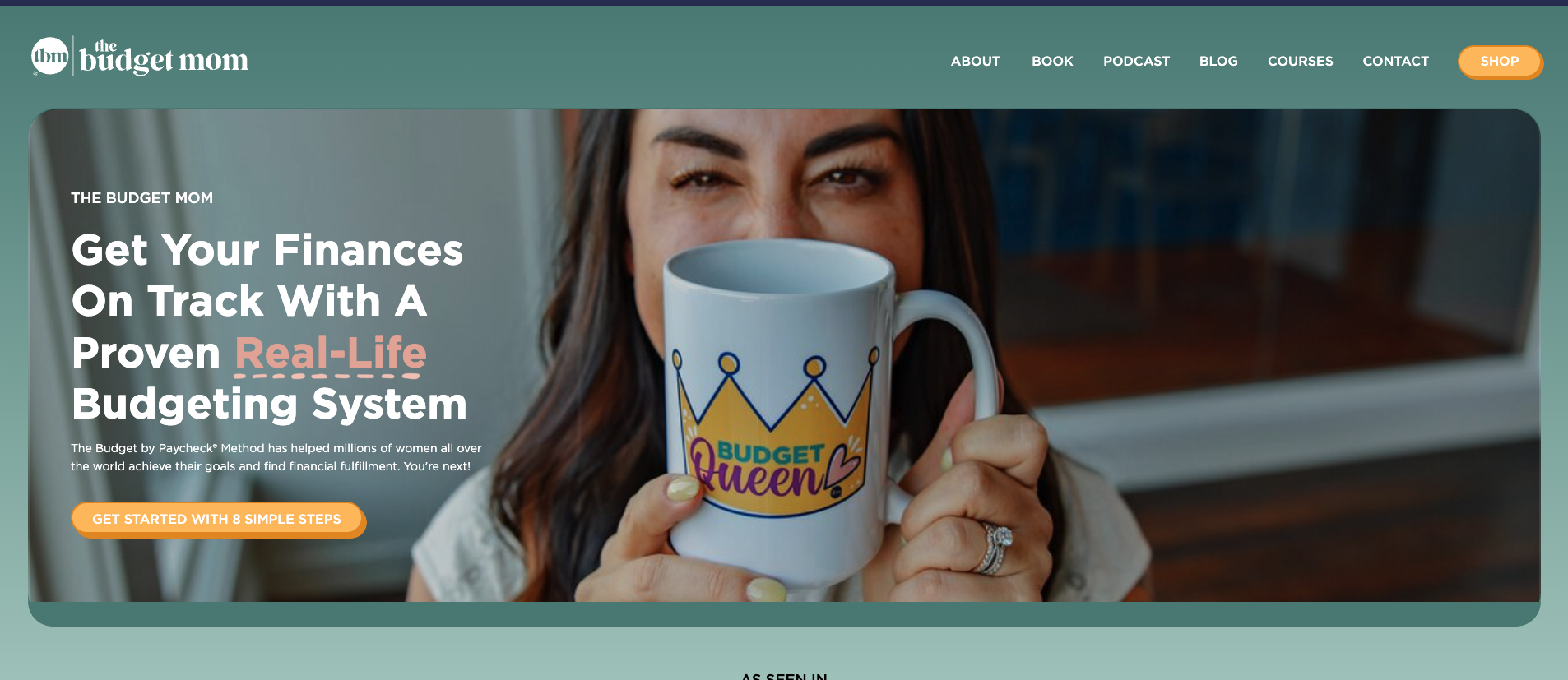 Created by Kumiko Love, this blog blends personal finance with real-life budgeting strategies. She shares simple, actionable advice on saving, paying off debt, and managing family finances, backed by personal finance experience. Her budgeting methods, printables, and digital products have built a strong community of readers looking for financial clarity.
Created by Kumiko Love, this blog blends personal finance with real-life budgeting strategies. She shares simple, actionable advice on saving, paying off debt, and managing family finances, backed by personal finance experience. Her budgeting methods, printables, and digital products have built a strong community of readers looking for financial clarity.
Sprout Social Insights
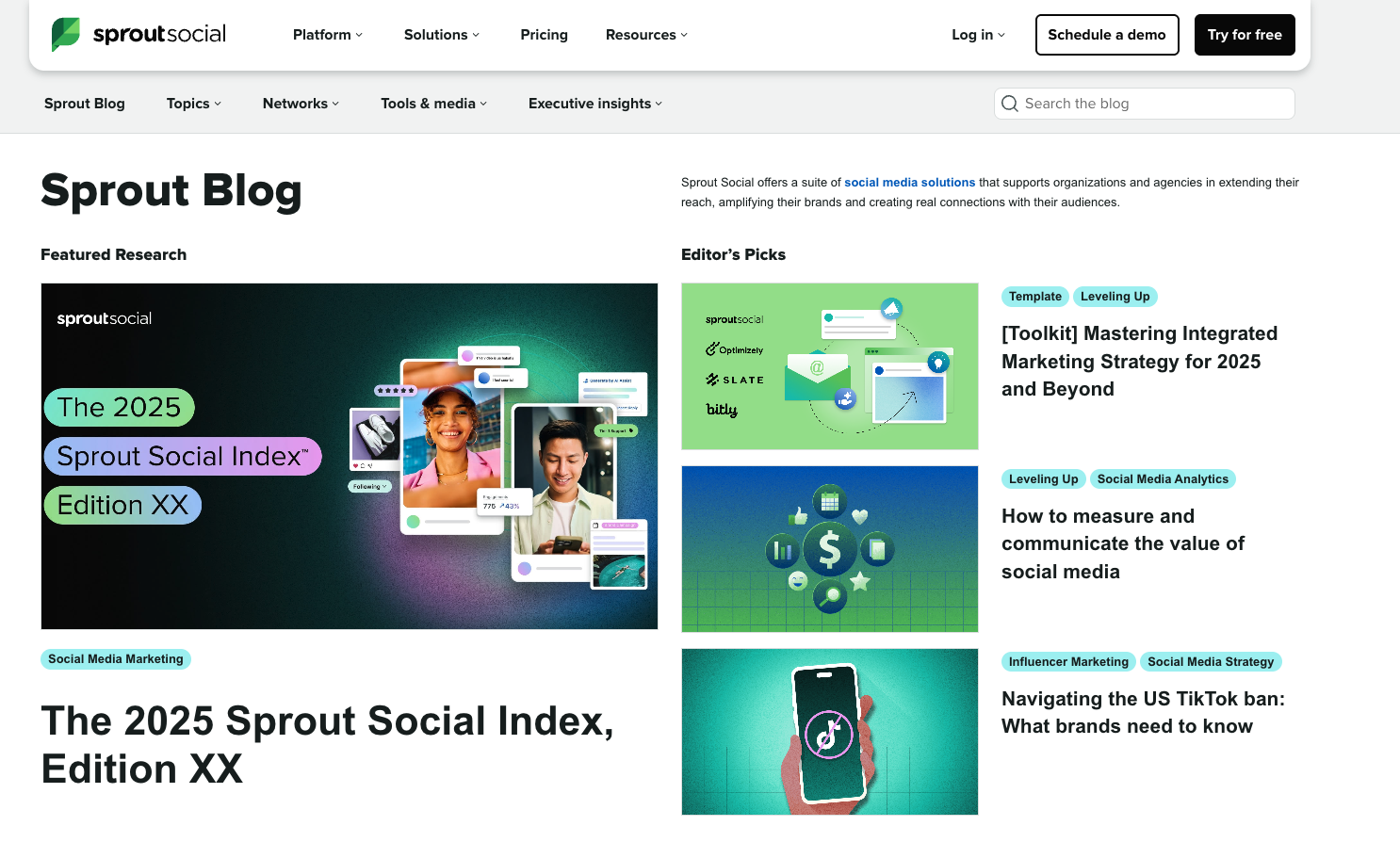 This blog supports Sprout’s platform with helpful, well-organized posts about social media marketing, reporting, and audience building. It uses consistent visuals, downloadable templates, and list-based articles to keep things readable.
This blog supports Sprout’s platform with helpful, well-organized posts about social media marketing, reporting, and audience building. It uses consistent visuals, downloadable templates, and list-based articles to keep things readable.
Tip for Scaling: Create a dedicated section for evergreen resources—like toolkits, webinars, and whitepapers. These help build authority and give your readers extra reasons to stay on-site.
Art, Design, and Photography Blog Examples
These blogs lean heavily on visuals, but it’s the mix of personal insight and strong layout choices that keep people engaged. Whether it’s daily inspiration, portfolio content, or behind-the-scenes looks, they know how to keep things simple, clean, and scrollable.
Zion Adventure Photog
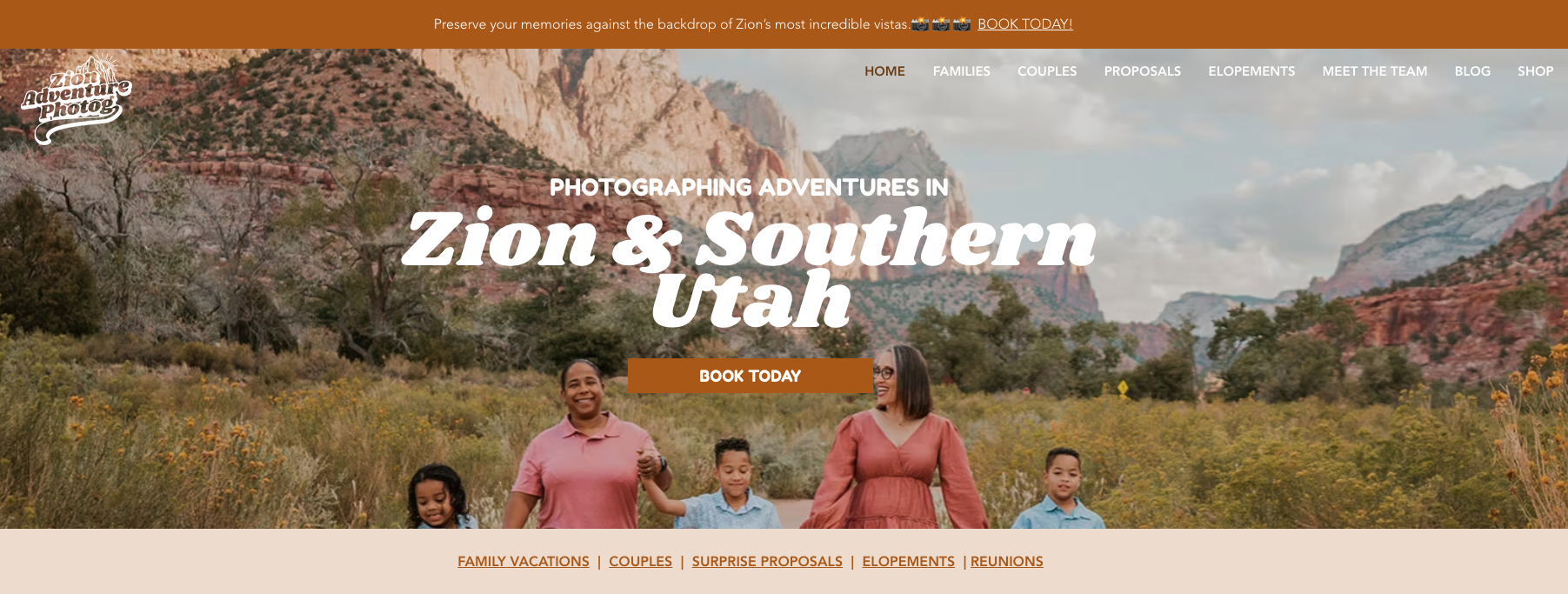 This photography blog blends stunning Zion National Park with personal stories and client features. It’s part portfolio, part blog, and part booking tool—perfect for a professional photographer who also wants to grow a local service-based business.
This photography blog blends stunning Zion National Park with personal stories and client features. It’s part portfolio, part blog, and part booking tool—perfect for a professional photographer who also wants to grow a local service-based business.
David duChemin
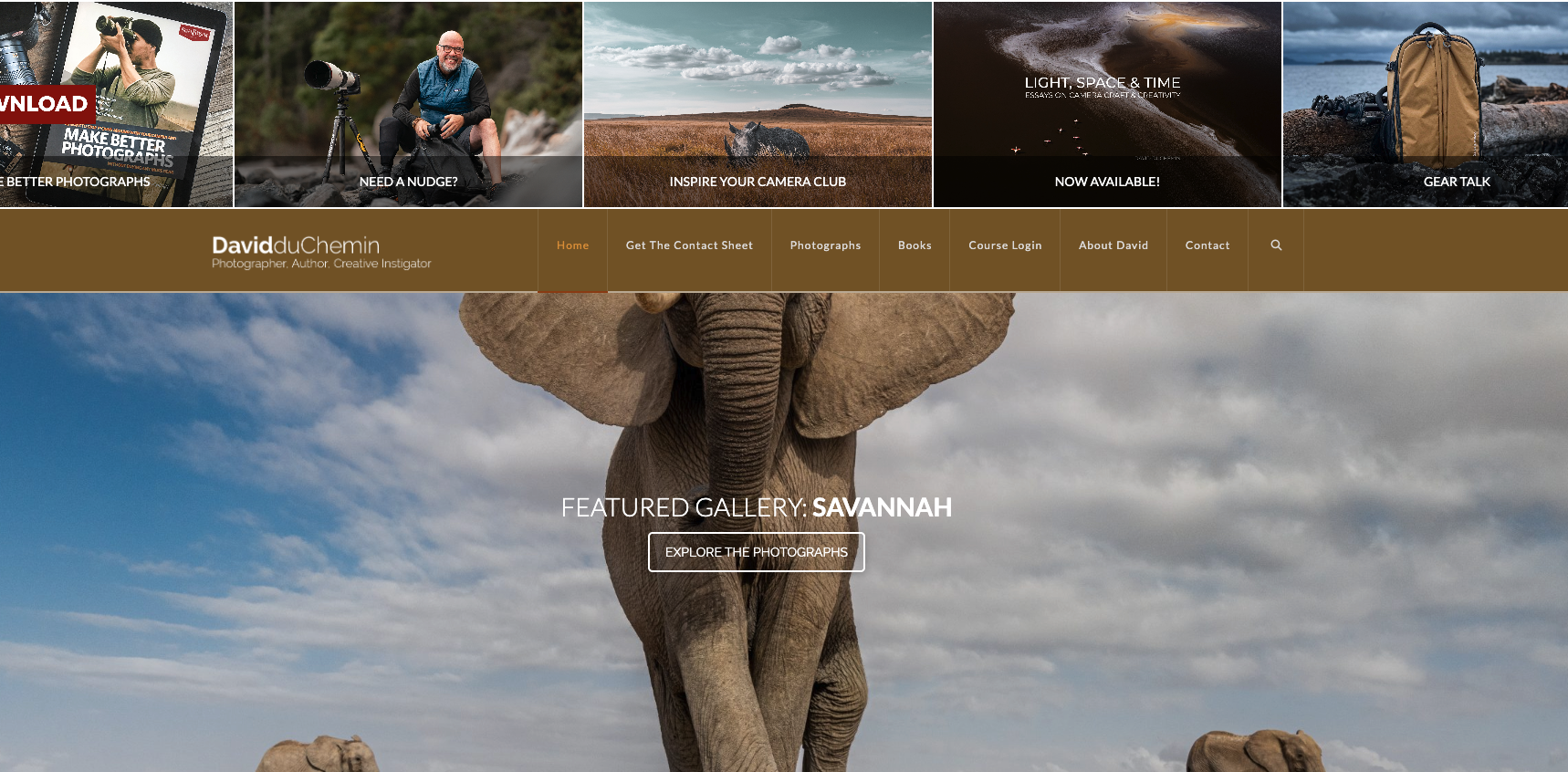 David’s posts focus on the creative process and storytelling in photography. It’s not gear-focused. Instead, he talks about intent, voice, and what it means to create work with purpose. Blog readers come for his perspective, not just his photos.
David’s posts focus on the creative process and storytelling in photography. It’s not gear-focused. Instead, he talks about intent, voice, and what it means to create work with purpose. Blog readers come for his perspective, not just his photos.
Humans of New York
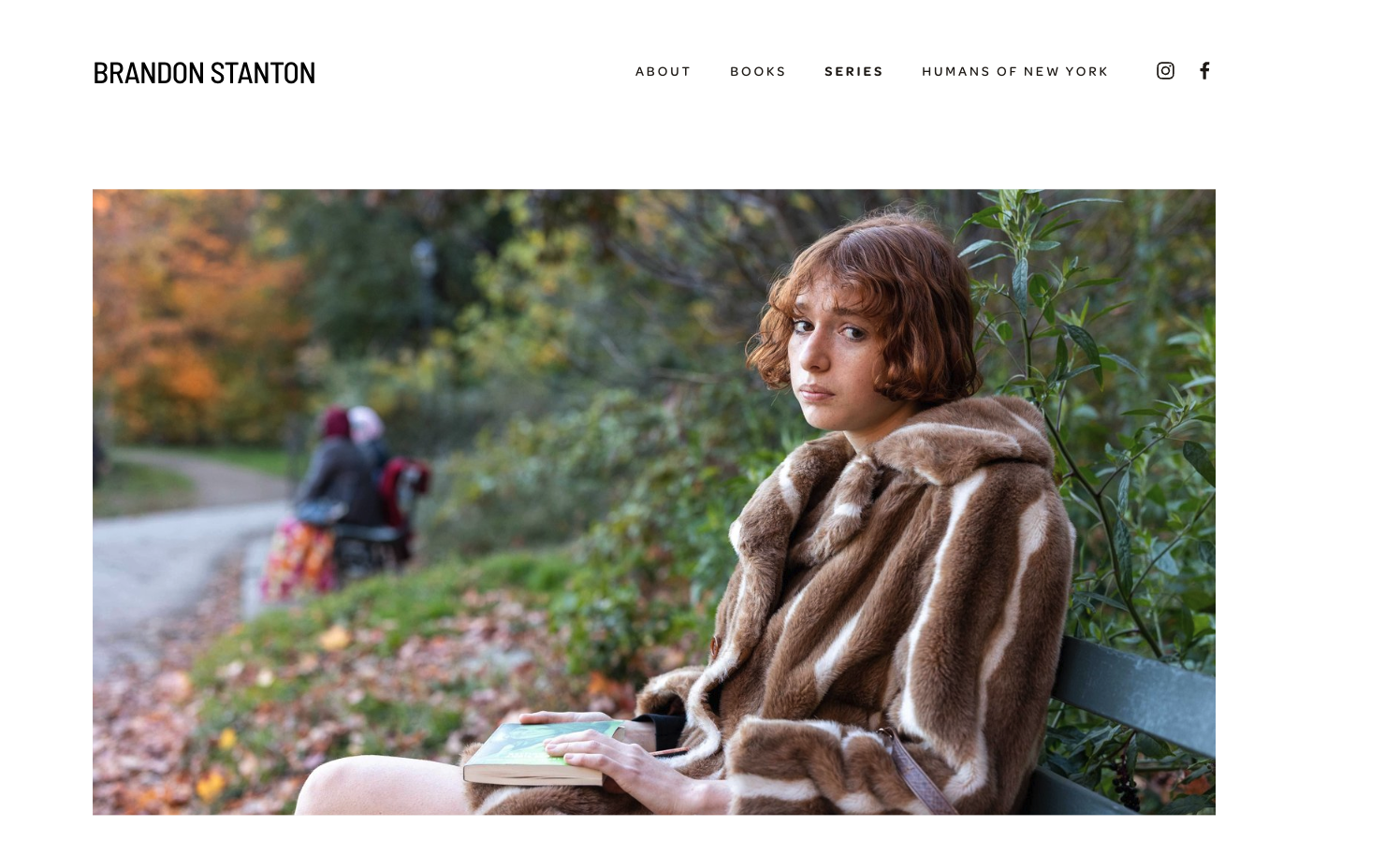 Started by Brandon Stanton, this photography blog pairs street portraits with short quotes or stories from New Yorkers. Each post is simple but powerful. It’s proof that a single paragraph and photo can speak volumes.
Started by Brandon Stanton, this photography blog pairs street portraits with short quotes or stories from New Yorkers. Each post is simple but powerful. It’s proof that a single paragraph and photo can speak volumes.
Colossal
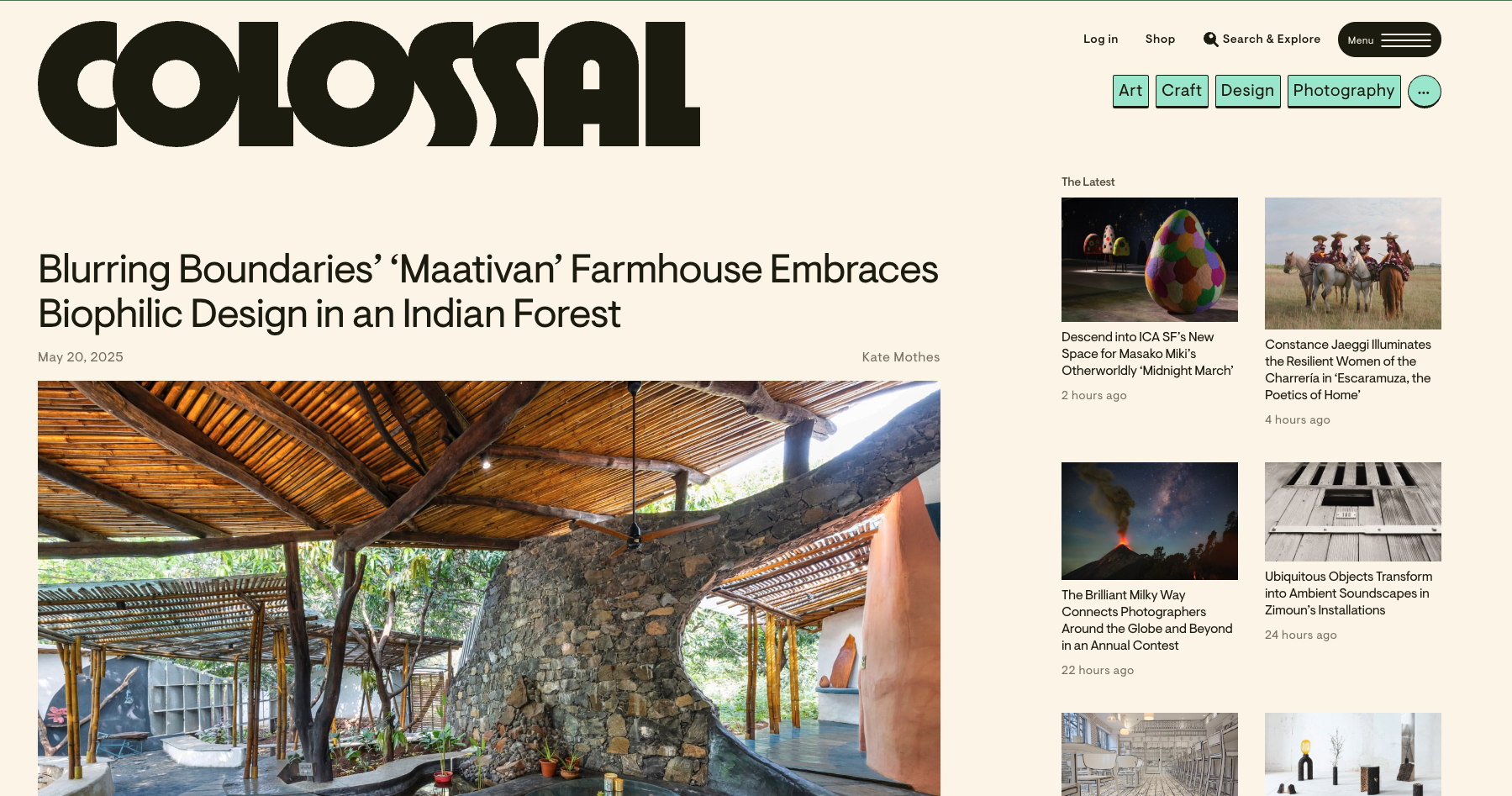 Colossal features artists and creatives from around the world. It’s one of the most visually striking blogs out there. Each post has minimal intro text, followed by bold visuals and credits. The site’s grid layout and trending features make it easy to explore new posts quickly.
Colossal features artists and creatives from around the world. It’s one of the most visually striking blogs out there. Each post has minimal intro text, followed by bold visuals and credits. The site’s grid layout and trending features make it easy to explore new posts quickly.
Abduzeedo
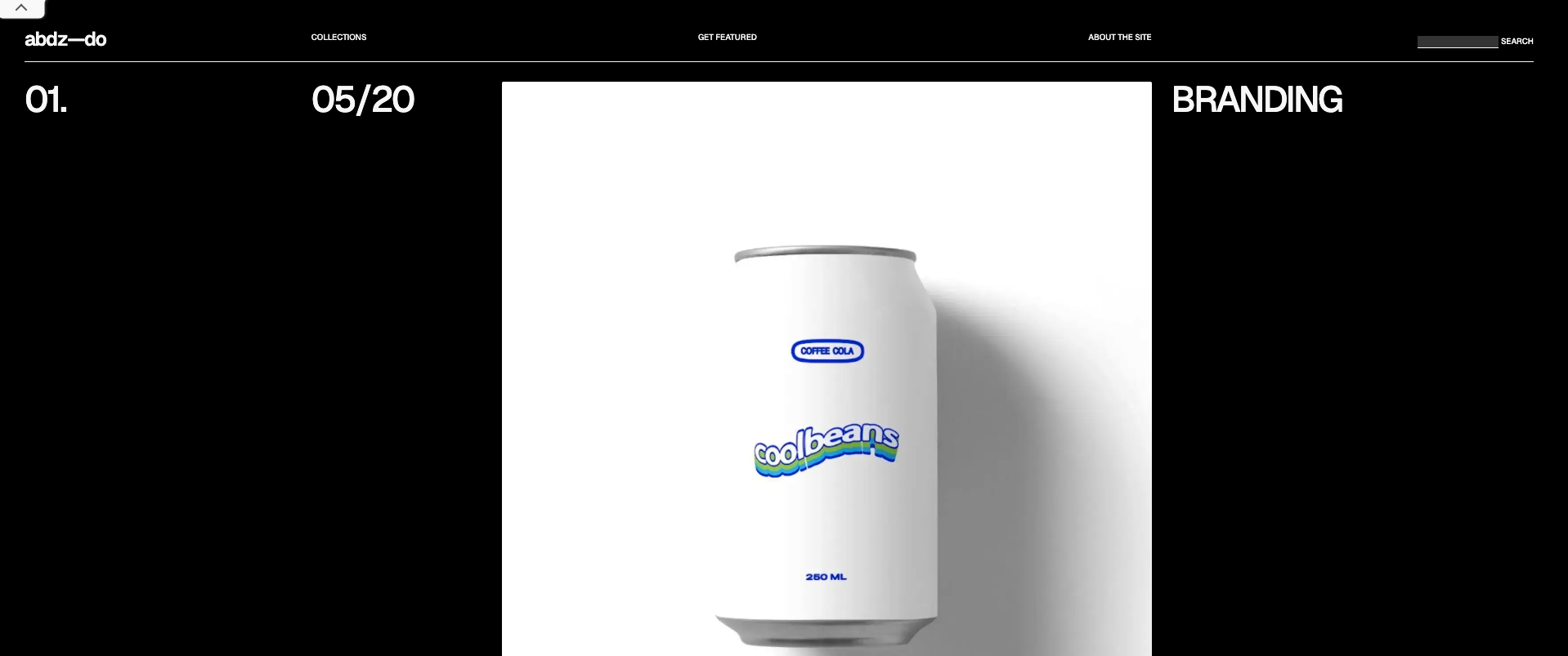 A design-heavy blog that showcases daily creative inspiration across graphic design, 3D, branding, photography tips, and more. It’s fast, clean, and full of tutorials and process breakdowns. Great for creative professionals who want a steady stream of ideas.
A design-heavy blog that showcases daily creative inspiration across graphic design, 3D, branding, photography tips, and more. It’s fast, clean, and full of tutorials and process breakdowns. Great for creative professionals who want a steady stream of ideas.
Add-on Tip: Create a “tools I use” page. This can include camera gear, software, or materials—especially helpful for affiliate links or recommendations that bring value without feeling like a sales pitch.
Blog Design Trends and UX Takeaways
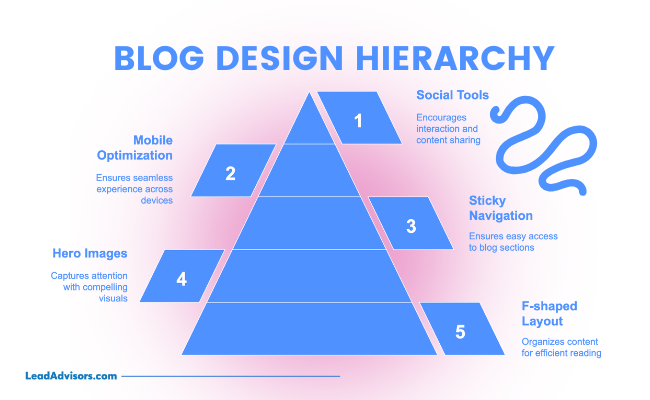
Effective blog design enhances user experience and encourages readers to engage more deeply with your content. Key principles include:
F-shaped Layout and Strong Hierarchy
Organize content to align with natural reading patterns, emphasizing important information. This approach guides readers’ eyes through your content efficiently, highlighting key points and calls to action.
Hero Images and Scannable Sections
Utilize compelling visuals at the top of your pages to capture attention. Break content into digestible sections with clear headings and bullet points, making it easier for readers to navigate and absorb information.
Sticky Navigation and Search Functionality
Implement a navigation menu that remains visible as users scroll, allowing easy access to different parts of your blog. Incorporate a search bar to help visitors find specific content quickly.
Mobile Optimization
Design your blog to be responsive, ensuring a seamless experience across various devices. This includes adjusting layouts, images, and text sizes to fit different screen sizes without compromising usability.
Social Sharing and Commenting Tools
Encourage interaction by integrating social sharing buttons and a commenting system. This not only fosters community engagement but also increases the reach of your content.
Tip: Utilize user behavior tools to gather data and refine UX based on actual user interactions. Tools like Hotjar or Microsoft Clarity can provide insights into how visitors interact with your site, helping you make informed improvements.
Designing for Everyone: Accessibility in Blogging
Good design isn’t just about aesthetics—it’s about ensuring everyone can access and enjoy your content. In 2025, accessibility isn’t optional. It’s a core part of effective user experience and even impacts your SEO.
Accessible blogs serve a wider audience, build trust, and rank better in search engines. Whether you’re writing recipe guides or running a tech blog, improving accessibility makes your content stronger, more inclusive, and future-proof.
Accessibility Basics to Implement
These foundational steps can drastically improve how inclusive your blog is:
- Alt Text for Images
Every image should have a short, descriptive alt attribute for screen readers and those with visual impairments. - Sufficient Color Contrast
Ensure text is readable against its background. Avoid light gray on white or neon text. Tools like WebAIM’s contrast checker help verify ratios. - Keyboard Navigation
Your blog should be fully usable without a mouse. This includes menus, forms, and embedded media players. - Consistent Headings and Layouts
Use heading tags (<h1>, <h2>, etc.) properly and avoid skipping levels. This improves navigation for screen reader users and assists with search indexing. - Descriptive Links
Avoid vague link text like “click here.” Use specific, context-rich anchor text like “read our accessibility checklist.”
Accessibility Tools to Audit Your Blog
Use these free tools to test and improve your blog’s accessibility:
- WAVE – Visual tool that highlights accessibility errors on your page
- axe DevTools – Browser extension for in-depth auditing
- Screen Reader Simulators – Use NVDA (Windows), VoiceOver (Mac), or browser-based tools to test navigation and text clarity
- Lighthouse (via Chrome DevTools) – Includes accessibility scoring as part of overall site health
Quick Accessibility Checklist
Use this as a mini self-audit:
- All images have descriptive alt text
- Text contrast meets WCAG standards
- Headings follow a clear hierarchy (no skips from H2 to H4)
- Blog is navigable via keyboard (no mouse required)
- Videos have captions or transcripts
- Links are descriptive and meaningful
- Forms have clear labels and error messages
Pro Tip: Accessibility isn’t just ethical—it’s SEO-friendly. Search engines reward clarity, fast load times, and semantic HTML. Designing for inclusion boosts visibility and user satisfaction.
Blog Monetization Techniques
Successful blogs often employ multiple revenue streams to ensure financial stability and growth opportunities:
Display Ads
Generate income through ad placements by partnering with ad networks like Google AdSense. This method is straightforward and scales with your traffic volume.
Affiliate Links
Earn commissions by promoting products or services relevant to your audience. Incorporate affiliate links naturally within your content to provide value while generating income.
Digital Products
Sell e-books, courses, or exclusive content directly to your readers. This approach allows you to leverage your expertise and provide additional value to your audience.
Services and Coaching
Offer professional services or personalized coaching sessions. This not only monetizes your skills but also strengthens your authority in your niche.
Subscriptions
Provide premium content through subscription models. This recurring revenue stream can offer financial predictability and deepen reader engagement.
Brand Partnerships
Collaborate with brands for sponsored content or campaigns. These partnerships can be lucrative and enhance your blog’s credibility when aligned with your audience’s interests.
Paid Search and Authority Placement
We also help clients publish brand reviews and evergreen content on high-authority sites. These placements add credibility, build backlinks, and support search visibility—key ingredients for long-term blog income and trust. To further enhance your outreach efforts, consider using an AI link building software or an outreach tool to automate processes and identify top-tier opportunities faster. These tools can streamline prospecting, personalize communication at scale, and improve response rates.
Tip: Diversify your income sources to reduce reliance on a single revenue stream, thereby providing financial stability and growth opportunities.
How to Start Your Blog
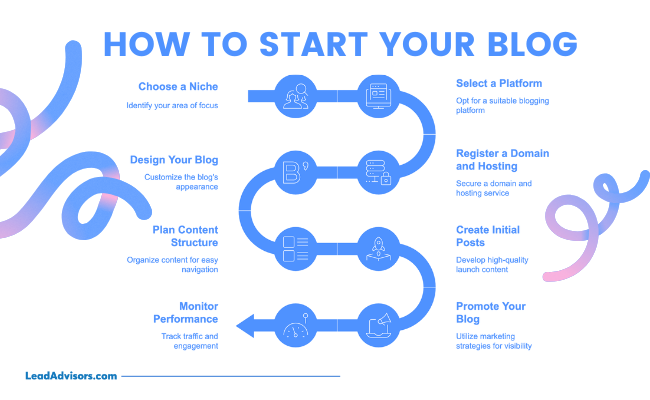
Embarking on your blogging journey involves several key steps:
Choose a Niche
Identify your area of focus based on your interests and expertise. A well-defined niche helps attract a targeted audience and establishes your authority.
Select a Platform
Opt for a blogging platform that suits your technical skills and customization needs. Popular options include WordPress, Wix, Ghost, and Squarespace.
Register a Domain and Hosting
Secure a domain name that reflects your brand and choose a reliable hosting service to ensure your blog is accessible and performs well.
Design Your Blog
Customize the appearance to reflect your brand identity and enhance user experience. Consider factors like layout, color schemes, and typography.
Plan Content Structure
Organize content into categories and tags for easy navigation. This structure helps readers find related content and improves SEO.
Create Initial Posts
Develop a few high-quality posts to launch your blog. Focus on providing value to your readers and showcasing your expertise.
Promote Your Blog
Utilize social media, SEO, and other marketing strategies to attract readers. Consistent promotion helps build your audience and increases visibility.
Monitor Performance
Use analytics tools to track traffic and engagement, adjusting strategies as needed. Regularly reviewing performance metrics allows you to make data-driven decisions.
Popular Blogging Platforms
Choosing the right platform matters. Each one offers different strengths depending on your goals, design needs, and technical skills.
WordPress
The most widely used option. Great for flexibility, SEO control, and scalability. Works best for those planning long-term growth.
Wix
Beginner-friendly with drag-and-drop features. Ideal for creators who want to get started quickly without technical setup.
Squarespace
Well-designed templates and an all-in-one system. A solid pick for visual-heavy blogs and creatives.
Ghost
Clean and fast with a minimalist editor. Favored by writers focused on content-first experiences.
Webflow
Best for custom designs without coding. Great for bloggers who want full layout control and advanced visuals.
Shopify (blogging built-in)
Primarily an eCommerce platform, but great for those who also want to build SEO traffic or share brand stories alongside their store.
Blogger
Google’s free platform. Simple to use, but limited for long-term customization or growth.
Each of these platforms can support a successful blog—it comes down to your goals, budget, and how much control you want.
What’s New in Blogging: 2025 Trends to Watch
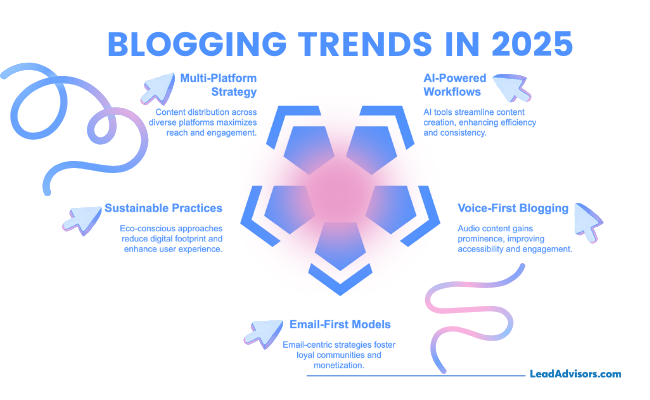
Blogging continues to evolve alongside technology, culture, and how we consume content. The strongest blogs in 2025 are those that embrace emerging tools and publishing models while staying grounded in clear, valuable content.
Here are the trends shaping the next generation of successful blogs:
1. AI-Powered Workflows
AI is no longer just a novelty—it’s becoming a behind-the-scenes assistant for bloggers. Many creators now use AI to:
- Brainstorm topic ideas and outlines
- Generate summaries and content expansions
- Create text-to-voice audio for accessibility and user convenience
While quality still depends on human insight, AI tools like ChatGPT, Jasper, or Claude help speed up content production and improve consistency.
2. Voice-First and Audio Blogging
With smart speakers, podcasts, and mobile voice assistants becoming part of daily life, audio-first blogging is on the rise. Platforms like Substack Voice and Wondercraft allow bloggers to turn written posts into high-quality audio versions with minimal effort.
This makes your content more accessible, increases time on page, and builds a stronger personal connection.
Voice Search Optimization: With more users browsing via Siri, Alexa, and mobile voice tools, structuring posts for voice readability is a growing priority.
3. Email-First and Community-Centered Models
The new blogging model often starts with the inbox. Platforms like ConvertKit Creator Network, Beehiiv, and Substack emphasize audience ownership, helping bloggers:
- Build a loyal subscriber base
- Monetize through memberships or premium content
- Drive recurring engagement through email-based blog updates
Email-first blogs tend to have higher retention and deeper relationships with readers than social media-based ones.
4. Sustainable Blogging Practices
Eco-conscious creators are prioritizing digital sustainability:
- Choosing green hosting providers that use renewable energy
- Simplifying site design to reduce page weight and server load
- Using fewer external scripts and optimizing images for fast, efficient load times
Minimalist design isn’t just a trend—it’s a sustainability strategy that benefits both the planet and the user experience.
5. Multi-Platform Blogging
Bloggers in 2025 think beyond the blog. They use their site as a central hub, but distribute content and conversation across:
- Threads, Mastodon, and federated platforms
- TikTok and Instagram Reels for visual content
- YouTube Shorts or full-length video walk-throughs
- Pinterest for lifestyle and DIY content syndication
The goal is to meet audiences where they are and then bring them back to the blog for deeper engagement.
Adding even one or two of these trends into your blogging strategy can help your site stand out in a saturated landscape, while preparing you for the next wave of digital publishing.
Final Thoughts
Starting a blog is more than posting your thoughts—it’s about creating something people want to return to. The strongest blogs focus on clear topics, clean design, and content that’s helpful or relatable. Over time, that mix builds trust and momentum.
If you’re ready to launch your own blog, we can build it for you—professionally designed, fully optimized, and ready to grow with you. Let’s make something people want to read.




